
10 Days of Holiday Spirit in Germany's Best Christmas Markets
 10 Day Tour of Munich, Nuremberg, Dresden and Berlin
10 Day Tour of Munich, Nuremberg, Dresden and Berlin
Overview
Trip Map
Itinerary
Inclusions
Reviews







10 Days 9 Nights
Best Time: Jan-Dec
Christmas Market
History Buffs
Enjoy 10 days of holiday spirit as you explore the best Christmas markets in Germany. You’ll wander the festively decorated markets of Munich, Nuremberg, Dresden, and Berlin, discovering how Germany celebrates and preserves timeless traditions while embracing the magic of the season. You'll take a day trip to charming Rothenburg ob der Tauber, savoring roasted chestnuts in a fairy-tale town that gives itself over to the Christmas experience. You’ll also experience some of Germany’s most impressive history, architecture, and culture, all made easy with your detailed Go Real Travel itinerary and mobile app.
- Experience Bavaria's biggest Christmas Markets in Munich and Nuremberg.
- Stroll through charming cobblestoned lanes in enchanting Rothenburg ob der Tauber.
- Discover the magic of Dresden's Christmas Market, Germany's oldest, filled with lights and carols.
- Relax and enjoy scenic winter landscapes as you travel between the cities by train.
- See iconic landmarks like the Brandenburg Gate and Berlin Wall on a private guided walk in Berlin.
Enjoy 10 days of holiday spirit as you explore the best Christmas markets in Germany. You’ll wander the festively decorated markets of Munich, Nuremberg, Dresden, and Berlin, discovering how Germany celebrates and preserves timeless traditions while embracing the magic of the season. You'll take a day trip to charming Rothenburg ob der Tauber, savoring roasted chestnuts in a fairy-tale town that gives itself over to the Christmas experience. You’ll also experience some of Germany’s most impressive history, architecture, and culture, all made easy with your detailed Go Real Travel itinerary and mobile app.
- Experience Bavaria's biggest Christmas Markets in Munich and Nuremberg.
- Stroll through charming cobblestoned lanes in enchanting Rothenburg ob der Tauber.
- Discover the magic of Dresden's Christmas Market, Germany's oldest, filled with lights and carols.
- Relax and enjoy scenic winter landscapes as you travel between the cities by train.
- See iconic landmarks like the Brandenburg Gate and Berlin Wall on a private guided walk in Berlin.

Old Town
Architecture

Residence Palace
Castles & Chateaux

Nuremberg Castle
Castles & Chateaux

Old Town
Historic Landmarks

The Albertinum
Museums & Galleries

Church of our Lady
Churches & Monasteries

Dresden Christmas Markets
Street Markets

The Brandenburg Gate
Historic Landmarks

The Berlin Wall
Historic Landmarks
Must see sights

Old Town
Architecture

Residence Palace
Castles & Chateaux

Nuremberg Castle
Castles & Chateaux

Old Town
Historic Landmarks

The Albertinum
Museums & Galleries

Church of our Lady
Churches & Monasteries

Dresden Christmas Markets
Street Markets

The Brandenburg Gate
Historic Landmarks

The Berlin Wall
Historic Landmarks
Starting from
$1415
per person
 Not included
Not included Secure Your Customizable Trip
Enter your details to embark on a journey that can be tailored just for you.
Start
Travelers
0 travelers
Add Room
Remove Room
Preferred Hotel Stars
Select Hotel Stars
Craft Your Own Itinerary
Select your interests and destinations for a trip plan inspired by you.
Trip Map & Itinerary
Enable/Disable Map Scrolling
Click To Make Map Interactive

Trip Timeline
 Edit Details
Edit DetailsArrival
2 nights
Munich
Germany
Train: 1.5h
2 nights
Nuremberg
Germany
Train: 2.5h
Train: 1.5h
2 nights
Dresden
Germany
Train: 2h
3 nights
Berlin
Germany
Departure
Day-By-Day Itinerary

Day 1
Arrive Munich
Day 1
Arrive Munich




To Be Determined
Arrival in Munich Airport and Transfer by Taxi or Train
Munich has one main airport, Munich International Airport, where almost all visitors arrive. Taxis are available directly at the terminal exit, or you can arrange a private transfer for added convenience. The cheapest and fastest way to reach central Munich from is by train. The regional "S-bahn" trains delivers you from the airport train station (just follow the signs) directly to Munich's main station (München hbf) in the center of the city, from where you can easily hail a taxi that will be much less expensive than from the airport.

Day 1
Arrive Munich


Day 1
Arrive Munich





To Be Determined:
Transfer from Airport
Mid-Day/Afternoon:
Altstadt
Afternoon/Late Afternoon:
Arts District
Early Evening:
Maxvorstadt


Day 2
Munich
Day 2
Munich




Early Morning/Morning
A Visit to Munich's Residence Palace
The Munich Residenz was the seat of Bavaria's Dukes and Kings from the middle ages until 1918. Originally a medieval castle, it was transformed over the centuries into a beautiful palace. Today it is open to the public and you can explore its magnificent interiors, numerous courtyards, and elegant garden. The living quarters of the royal family have been transformed into a museum which provides a fascinating glimpse into the lives of Kings and Queens. You can also peruse numerous jewels, gold objects, and other precious items which are held in the Residenz Schatzkammer (treasury).

Cuvilliés-Theatre
Visit what is perhaps the most ostentatious and sensually overwhelming building in Munich.
Show More

Odeonsplatz
See the square where Hitler's Beer Hall Putsch came to a bloody end.
Show More

Residenz Palace Museum
Wander where you will, audio guide in hand, through the spectactular royal residence.
Show More

Cuvilliés-Theatre
Visit what is perhaps the most ostentatious and sensually overwhelming building in Munich.
Show More

Odeonsplatz
See the square where Hitler's Beer Hall Putsch came to a bloody end.
Show More

Residenz Palace Museum
Wander where you will, audio guide in hand, through the spectactular royal residence.
Show More

Cuvilliés-Theatre
Visit what is perhaps the most ostentatious and sensually overwhelming building in Munich.
Show More
prev
next

Day 2
Munich

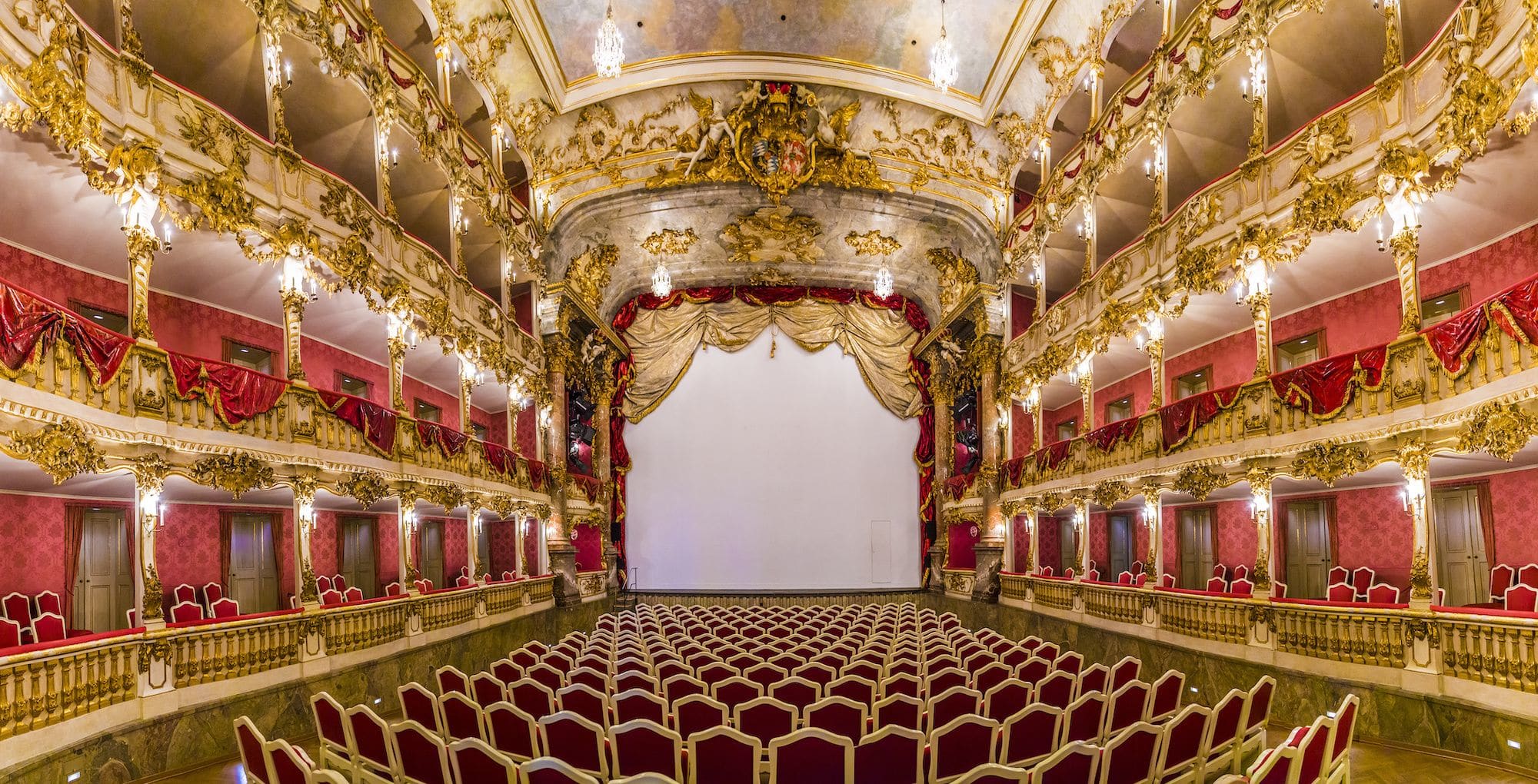
Cuvilliés-Theatre
 Highlight of Residence Palace
Highlight of Residence PalaceVisit what is perhaps the most ostentatious and sensually overwhelming building in Munich.
The exceptionally extravagant court theatre was built by Elector Max III Joseph's court architect François Cuvilliés between 1751 and 1755, and was intended to showcase Munich as a home to the arts and the enlightenment. It only survived the destruction of WWII because the elaborately carved tiers of boxes were removed from their original location in the Alte Residenztheater building for safekeeping. It's still used as a theatre today.FYI - to visit the Cuvilliés-Theatre you need to exit the museum and walk around the palace to get onto Residenzstraße and then re-enter the palace and cross through either the Chapel Courtyard or the Imperial Courtyard.
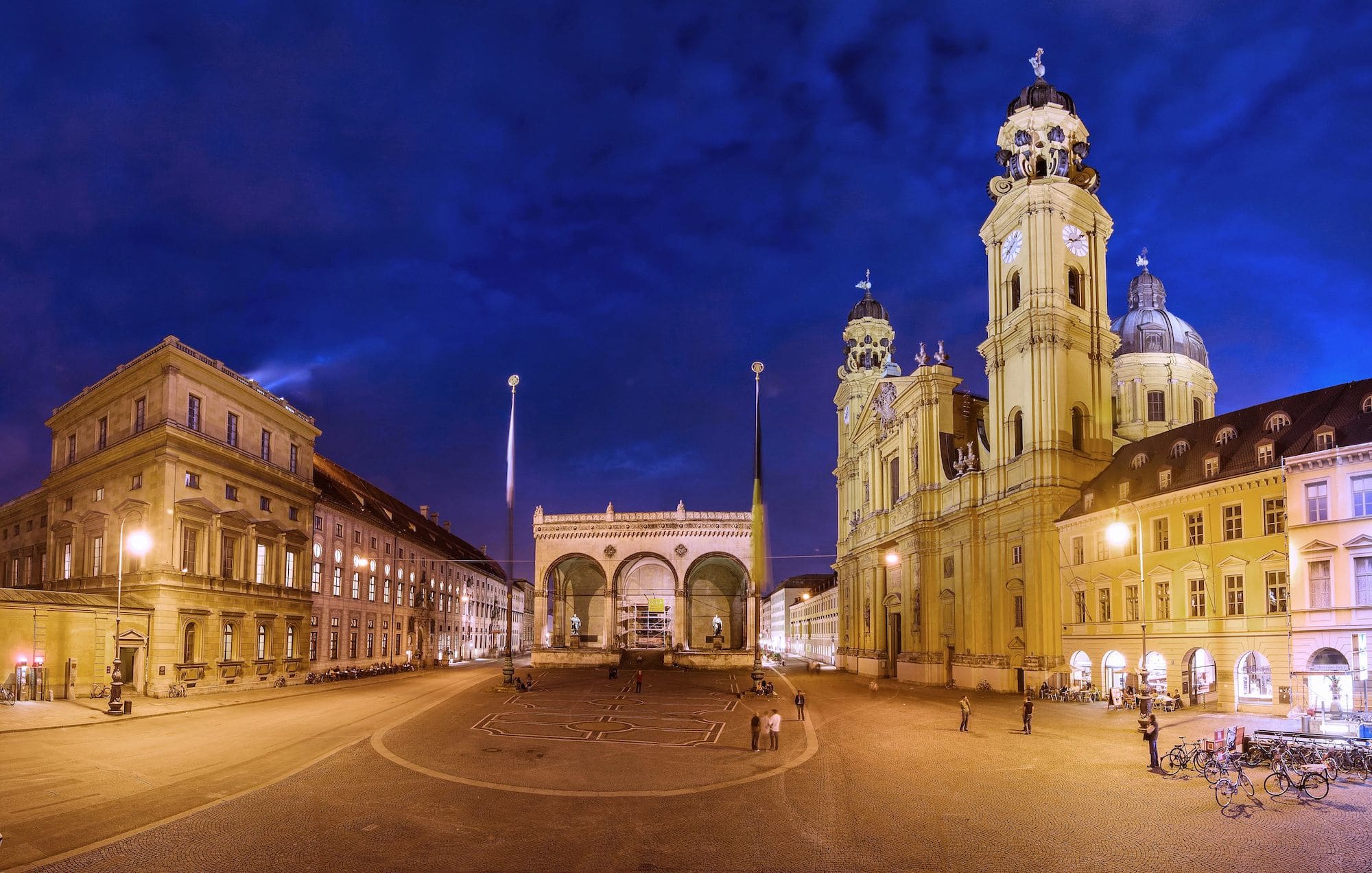
Odeonsplatz
 Highlight of Residence Palace
Highlight of Residence PalaceSee the square where Hitler's Beer Hall Putsch came to a bloody end.
The square directly adjacent to the Residence is the Odeonsplatz, which is guarded by the Feldherrnhalle (Field Marshalls' Hall) in honor of the Bavarian army. It was here that Hitler's Beer Hall Putsch in 1923 came to a bloody end in a gun battle with the police. During the Nazi regime, anyone passing the Feldherrnhalle was obliged to give the Nazi salute, which prompted some locals to instead take a side street. The Nazis derogatorily nicknamed it the Shirkers' Alley, but the 'shirkers' are memorialized in a trail of brass cobblestones. Also on the square is the bright yellow Theatinerkirche with its two massive twin towers. It was the personal church of Bavaria's rulers and many of them are interred there.

Residenz Palace Museum
 Highlight of Residence Palace
Highlight of Residence PalaceWander where you will, audio guide in hand, through the spectactular royal residence.
You'll experience jaw-dropping architecture and beautiful artwork as you explore the museum and the adjacent Royal Treasury. Among the many highlights, unmissable is the Antiquarium, the largest and most lavish Renaissance hall north of the Alps. The window reveals are decorated with 102 views of towns, markets, and palaces in what was then the Duchy of Bavaria, providing an unique insight into how the country once looked. The Rich Chapel (Reiche Kapelle) was the private place of worship of Duke Maximilian I and his wife, and it was decorated with particular magnificence using colored marble and gilt reliefs. The Ornate Rooms (Reiche Zimmer) meanwhile represent a high point of the court Rococo style, and are works of art in their own right.

Cuvilliés-Theatre
 Highlight of Residence Palace
Highlight of Residence PalaceVisit what is perhaps the most ostentatious and sensually overwhelming building in Munich.
The exceptionally extravagant court theatre was built by Elector Max III Joseph's court architect François Cuvilliés between 1751 and 1755, and was intended to showcase Munich as a home to the arts and the enlightenment. It only survived the destruction of WWII because the elaborately carved tiers of boxes were removed from their original location in the Alte Residenztheater building for safekeeping. It's still used as a theatre today.FYI - to visit the Cuvilliés-Theatre you need to exit the museum and walk around the palace to get onto Residenzstraße and then re-enter the palace and cross through either the Chapel Courtyard or the Imperial Courtyard.

Odeonsplatz
 Highlight of Residence Palace
Highlight of Residence PalaceSee the square where Hitler's Beer Hall Putsch came to a bloody end.
The square directly adjacent to the Residence is the Odeonsplatz, which is guarded by the Feldherrnhalle (Field Marshalls' Hall) in honor of the Bavarian army. It was here that Hitler's Beer Hall Putsch in 1923 came to a bloody end in a gun battle with the police. During the Nazi regime, anyone passing the Feldherrnhalle was obliged to give the Nazi salute, which prompted some locals to instead take a side street. The Nazis derogatorily nicknamed it the Shirkers' Alley, but the 'shirkers' are memorialized in a trail of brass cobblestones. Also on the square is the bright yellow Theatinerkirche with its two massive twin towers. It was the personal church of Bavaria's rulers and many of them are interred there.

Residenz Palace Museum
 Highlight of Residence Palace
Highlight of Residence PalaceWander where you will, audio guide in hand, through the spectactular royal residence.
You'll experience jaw-dropping architecture and beautiful artwork as you explore the museum and the adjacent Royal Treasury. Among the many highlights, unmissable is the Antiquarium, the largest and most lavish Renaissance hall north of the Alps. The window reveals are decorated with 102 views of towns, markets, and palaces in what was then the Duchy of Bavaria, providing an unique insight into how the country once looked. The Rich Chapel (Reiche Kapelle) was the private place of worship of Duke Maximilian I and his wife, and it was decorated with particular magnificence using colored marble and gilt reliefs. The Ornate Rooms (Reiche Zimmer) meanwhile represent a high point of the court Rococo style, and are works of art in their own right.

Cuvilliés-Theatre
 Highlight of Residence Palace
Highlight of Residence PalaceVisit what is perhaps the most ostentatious and sensually overwhelming building in Munich.
The exceptionally extravagant court theatre was built by Elector Max III Joseph's court architect François Cuvilliés between 1751 and 1755, and was intended to showcase Munich as a home to the arts and the enlightenment. It only survived the destruction of WWII because the elaborately carved tiers of boxes were removed from their original location in the Alte Residenztheater building for safekeeping. It's still used as a theatre today.FYI - to visit the Cuvilliés-Theatre you need to exit the museum and walk around the palace to get onto Residenzstraße and then re-enter the palace and cross through either the Chapel Courtyard or the Imperial Courtyard.
prev
next

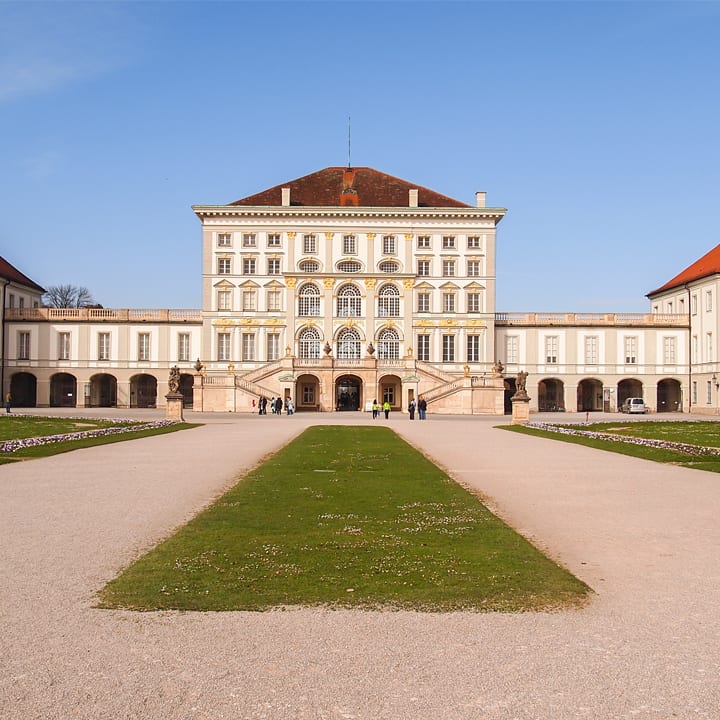
Day 3
Munich to Nuremberg
Day 3
Munich to Nuremberg





Early Morning/Morning
Visit to Nymphenburg Palace
Only a short tram ride from Munich's city center, you'll find a lovely palace scenically situated amidst a large park. Created as the summer residence of the Bavarian electors, the size, and dimension of the grounds, designed by a student of the Palace of Versailles' landscape designer, is astounding. The main palace building consists of a large villa and two wings of creaking parquet floors and sumptuous period rooms. The palace managed to survive the carpet bombing of the Second World War that destroyed around 80% of the inner city.

Gallery of Beauties
Stare into the eyes of King Ludwig I's mistresses.
Show More

Nymphenburg Garden
Escape to the favorite natural retreat of locals.
Show More

Marstallmuseum
Stare up close at the splendid and ostentatious carriages built for Bavaria's rulers.
Show More

Botanical Garden
Visit M unich's large Botanical Gardens just north of the Nymphenburg Palace.
Show More

Gallery of Beauties
Stare into the eyes of King Ludwig I's mistresses.
Show More

Nymphenburg Garden
Escape to the favorite natural retreat of locals.
Show More

Marstallmuseum
Stare up close at the splendid and ostentatious carriages built for Bavaria's rulers.
Show More

Botanical Garden
Visit M unich's large Botanical Gardens just north of the Nymphenburg Palace.
Show More
prev
next

Day 3
Munich to Nuremberg


Gallery of Beauties
 Highlight of Nymphenburg Palace
Highlight of Nymphenburg PalaceStare into the eyes of King Ludwig I's mistresses.
One of the high points of the magnificent palace is the Schönheitengalerie, or the Gallery of Beauties, featuring 38 portraits of attractive females admired by King Ludwig I, including some of his mistresses, many with fascinating stories of their own related via the audio guide. Be sure to check out the story of Ludwig's longstanding infamous mistress, the Irish dancer Lola Montez, over whom Ludwig lost his crown.
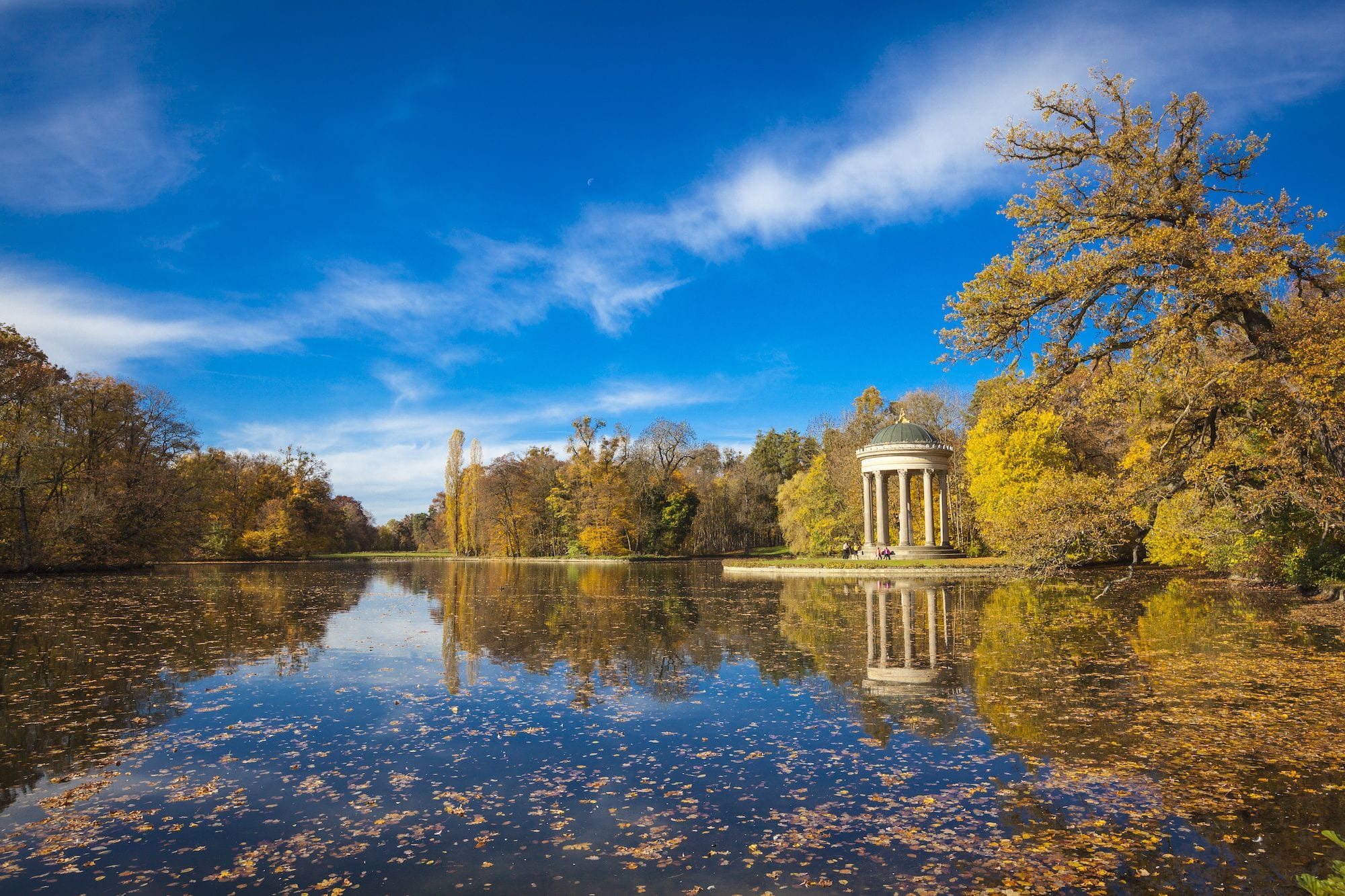
Nymphenburg Garden
 Highlight of Nymphenburg Palace
Highlight of Nymphenburg PalaceEscape to the favorite natural retreat of locals.
The sprawling park behind Nymphenburg Palace is a favorite spot with Munich residents and visitors alike. It started out as an Italian garden and was later redesigned in the French style, but in the 19th century most of the park was transformed into the more natural English style. It is embellished with a number of water features, including a large lake, a cascade and a 1.5 mile-long canal - a great venue for ice skating and ice curling when it freezes over in winter.

Marstallmuseum
 Highlight of Nymphenburg Palace
Highlight of Nymphenburg PalaceStare up close at the splendid and ostentatious carriages built for Bavaria's rulers.
Also housed in the main building is the Marstallmuseum, displaying royal coaches and riding gear dripping with gild and golden ornamentation, including King Ludwig II's outrageously fairy tale–like rococo sleigh, ingeniously fitted with oil lamps for his impromptu nocturnal outings. Upstairs is the world's largest collection of porcelain made by the famous Nymphenburger Manufaktur. Also known as the Sammlung Bäuml, it presents the entire product palette from the company's founding in 1747 until 1930.

Botanical Garden
 Highlight of Nymphenburg Palace
Highlight of Nymphenburg PalaceVisit M unich's large Botanical Gardens just north of the Nymphenburg Palace.
There are over 52 acres in the gardens, included greenhouses, a lake, a fountain, and houses dedicated to Africa and Madagascar, Mexico, palms and cactuses, and other themes.

Gallery of Beauties
 Highlight of Nymphenburg Palace
Highlight of Nymphenburg PalaceStare into the eyes of King Ludwig I's mistresses.
One of the high points of the magnificent palace is the Schönheitengalerie, or the Gallery of Beauties, featuring 38 portraits of attractive females admired by King Ludwig I, including some of his mistresses, many with fascinating stories of their own related via the audio guide. Be sure to check out the story of Ludwig's longstanding infamous mistress, the Irish dancer Lola Montez, over whom Ludwig lost his crown.

Nymphenburg Garden
 Highlight of Nymphenburg Palace
Highlight of Nymphenburg PalaceEscape to the favorite natural retreat of locals.
The sprawling park behind Nymphenburg Palace is a favorite spot with Munich residents and visitors alike. It started out as an Italian garden and was later redesigned in the French style, but in the 19th century most of the park was transformed into the more natural English style. It is embellished with a number of water features, including a large lake, a cascade and a 1.5 mile-long canal - a great venue for ice skating and ice curling when it freezes over in winter.

Marstallmuseum
 Highlight of Nymphenburg Palace
Highlight of Nymphenburg PalaceStare up close at the splendid and ostentatious carriages built for Bavaria's rulers.
Also housed in the main building is the Marstallmuseum, displaying royal coaches and riding gear dripping with gild and golden ornamentation, including King Ludwig II's outrageously fairy tale–like rococo sleigh, ingeniously fitted with oil lamps for his impromptu nocturnal outings. Upstairs is the world's largest collection of porcelain made by the famous Nymphenburger Manufaktur. Also known as the Sammlung Bäuml, it presents the entire product palette from the company's founding in 1747 until 1930.

Botanical Garden
 Highlight of Nymphenburg Palace
Highlight of Nymphenburg PalaceVisit M unich's large Botanical Gardens just north of the Nymphenburg Palace.
There are over 52 acres in the gardens, included greenhouses, a lake, a fountain, and houses dedicated to Africa and Madagascar, Mexico, palms and cactuses, and other themes.
prev
next

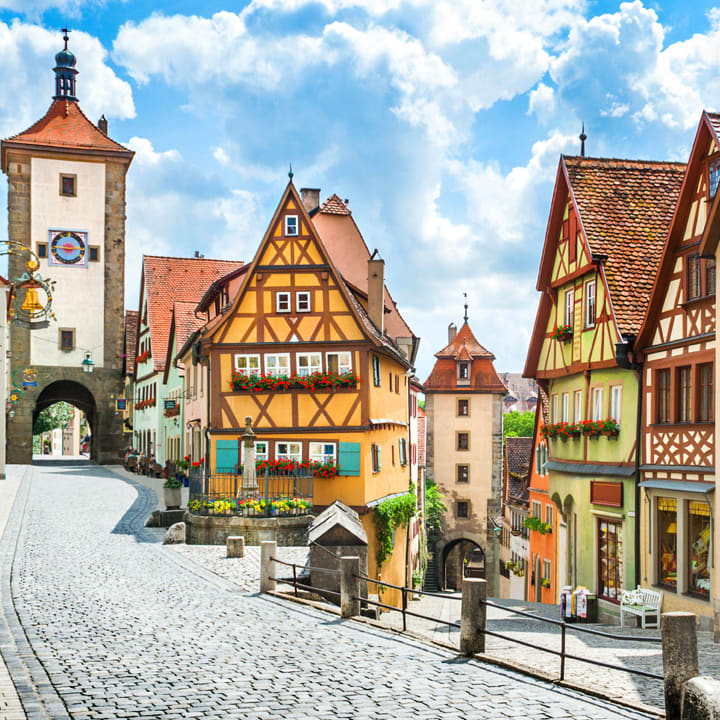
Day 4
Nuremberg
Day 4
Nuremberg


Early Morning to Afternoon
Excursion to Rothenburg ob der Tauber
Massive stone walls studded with 42 towers; half-timbered colorful houses with red-tiled roofs; cobblestone streets and flower-filled window boxes: this is Rothenburg ob der Tauber, one of the most fairy-tale towns in all of Europe, and the most popular stop on Germany's famous "Romantic Road". This little slice of storybook heaven is one of the most photographed towns in Europe, with thousands of visitors from all over the world coming to experience its magical atmosphere. If traveling by train, it is located only a little more than an hour from Nuremberg, although you will need to make two connections on the journey.

Imperial Town Museum
Take a peek at what may be Germany's oldest kitchen and learn a bit of local lore and history.
Show More

Rothenburg City Wall
Peer over the red rooftops of Rothenburg as you walk its centuries-old battlements.
Show More

Christmas Store & German Christmas Museum
Experience a traditional German Christmas, regardless of when you visit.
Show More

Rothenburg Market Square
Stop for a coffee or beer and enjoy the ambience in this lovely square.
Show More

Plönlein (Little Square)
See one of the most photographed spots in Europe with your own eyes.
Show More

Imperial Town Museum
Take a peek at what may be Germany's oldest kitchen and learn a bit of local lore and history.
Show More

Rothenburg City Wall
Peer over the red rooftops of Rothenburg as you walk its centuries-old battlements.
Show More

Christmas Store & German Christmas Museum
Experience a traditional German Christmas, regardless of when you visit.
Show More

Rothenburg Market Square
Stop for a coffee or beer and enjoy the ambience in this lovely square.
Show More

Plönlein (Little Square)
See one of the most photographed spots in Europe with your own eyes.
Show More

Imperial Town Museum
Take a peek at what may be Germany's oldest kitchen and learn a bit of local lore and history.
Show More
prev
next

Day 4
Nuremberg


Imperial Town Museum
 Highlight of Rothenburg
Highlight of RothenburgTake a peek at what may be Germany's oldest kitchen and learn a bit of local lore and history.
Since 1936, the Imperial Town Museum located on Klosterhof street, has been housed in the former Dominican convent, which was dissolved in 1544. Visit the museum for an interesting experience of Rothenburg’s history and an impressive array of cultural artifacts and beautiful artwork. You can also visit the kitchen, which is said to date back to the late 1200s and is considered to be one of the oldest kitchens in Germany.

Rothenburg City Wall
 Highlight of Rothenburg
Highlight of RothenburgPeer over the red rooftops of Rothenburg as you walk its centuries-old battlements.
A must do while visiting Rothenburg is to take an hour or so to walk the historical walls around part of the Old Town. Stretching 2.5 miles (roughly 4km) around Rothenburg and guarded by 70 towers, walking around the covered ramparts of the Medieval City Wall is a magical experience. For those who wish to do a short section of the wall, you can start from the Rödertor Gateway which you may have passed through on entering the Old Town. For those adventurous travelers who wish to walk the whole wall, you can start from the Spitaltor, a massive round gatehouse located towards the south of the town, and continue to the final walkable gate, the Klingentor, located towards the north of the town. To start your walk, you simply need to climb the steep steps at the gate you wish to start. For those who are interested, a guided city wall tour is offered from the tourist information point next to the Market Square.
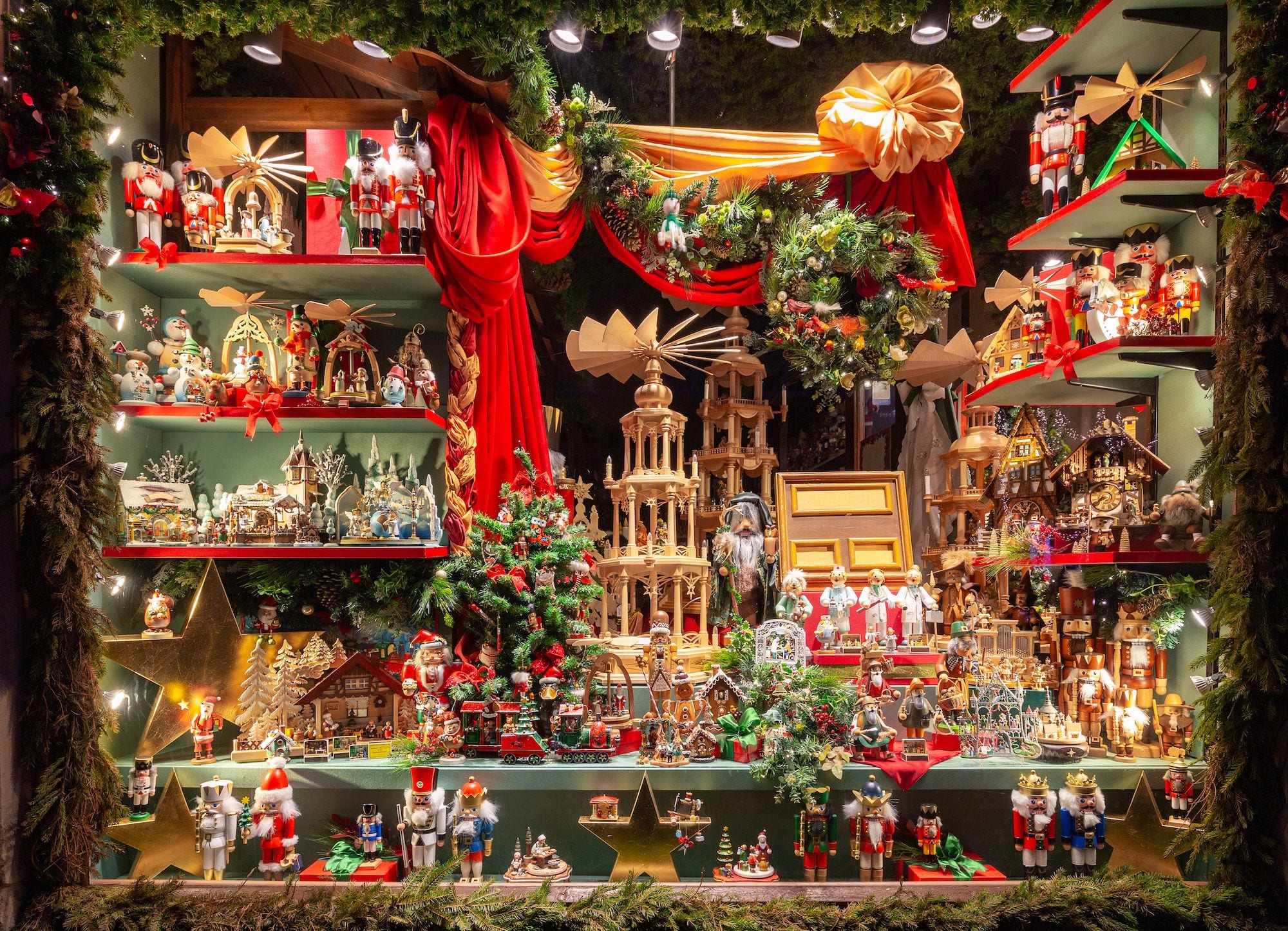
Christmas Store & German Christmas Museum
 Highlight of Rothenburg
Highlight of RothenburgExperience a traditional German Christmas, regardless of when you visit.
The famous Käthe Wohlfahrt Christmas decorations brand moved their flagship store in Rothenburg in 1977, and ever since, the town has been known for its unique Christmas Village and Museum. Next door to the store you will discover the German Christmas Museum. Covering over 2500 square foot, the museum covers hundreds of years of Christmas history and traditions in Germany.

Rothenburg Market Square
 Highlight of Rothenburg
Highlight of RothenburgStop for a coffee or beer and enjoy the ambience in this lovely square.
The Market Square and Old Town Hall, surrounded by splendid patrician houses, is where all the action takes places and where you will find the majority of the Christmas Stalls during Advent. The white Ratstrinkstube building to the right of the town hall features a red clock, where every hour between 10 am and 10 pm clockwork figures entertain visitors below. For one of the best view of Rothenburg, head up the Town Hall Tower. As one of the tallest towers in the Rothenburg, it was an important part of the historical city’s defense. The main purpose of the tower was to watch for fires, providing a quick and easy way to communicate with the city wall towers. We recommend only the physically fit attempt to conquer its 222 steps and steep ladder to the observational gallery.

Plönlein (Little Square)
 Highlight of Rothenburg
Highlight of RothenburgSee one of the most photographed spots in Europe with your own eyes.
You will surely recognize this small square known as the “Plönlein” (Little Square). It's narrow half-timbered building with a small fountain in front, framed by the Kobolzeller tower is one of the most famous postcard images of Rothenburg ob der Tauber. In the summer, hordes of tourists come to this spot to take the same obligatory photo.

Imperial Town Museum
 Highlight of Rothenburg
Highlight of RothenburgTake a peek at what may be Germany's oldest kitchen and learn a bit of local lore and history.
Since 1936, the Imperial Town Museum located on Klosterhof street, has been housed in the former Dominican convent, which was dissolved in 1544. Visit the museum for an interesting experience of Rothenburg’s history and an impressive array of cultural artifacts and beautiful artwork. You can also visit the kitchen, which is said to date back to the late 1200s and is considered to be one of the oldest kitchens in Germany.

Rothenburg City Wall
 Highlight of Rothenburg
Highlight of RothenburgPeer over the red rooftops of Rothenburg as you walk its centuries-old battlements.
A must do while visiting Rothenburg is to take an hour or so to walk the historical walls around part of the Old Town. Stretching 2.5 miles (roughly 4km) around Rothenburg and guarded by 70 towers, walking around the covered ramparts of the Medieval City Wall is a magical experience. For those who wish to do a short section of the wall, you can start from the Rödertor Gateway which you may have passed through on entering the Old Town. For those adventurous travelers who wish to walk the whole wall, you can start from the Spitaltor, a massive round gatehouse located towards the south of the town, and continue to the final walkable gate, the Klingentor, located towards the north of the town. To start your walk, you simply need to climb the steep steps at the gate you wish to start. For those who are interested, a guided city wall tour is offered from the tourist information point next to the Market Square.

Christmas Store & German Christmas Museum
 Highlight of Rothenburg
Highlight of RothenburgExperience a traditional German Christmas, regardless of when you visit.
The famous Käthe Wohlfahrt Christmas decorations brand moved their flagship store in Rothenburg in 1977, and ever since, the town has been known for its unique Christmas Village and Museum. Next door to the store you will discover the German Christmas Museum. Covering over 2500 square foot, the museum covers hundreds of years of Christmas history and traditions in Germany.

Rothenburg Market Square
 Highlight of Rothenburg
Highlight of RothenburgStop for a coffee or beer and enjoy the ambience in this lovely square.
The Market Square and Old Town Hall, surrounded by splendid patrician houses, is where all the action takes places and where you will find the majority of the Christmas Stalls during Advent. The white Ratstrinkstube building to the right of the town hall features a red clock, where every hour between 10 am and 10 pm clockwork figures entertain visitors below. For one of the best view of Rothenburg, head up the Town Hall Tower. As one of the tallest towers in the Rothenburg, it was an important part of the historical city’s defense. The main purpose of the tower was to watch for fires, providing a quick and easy way to communicate with the city wall towers. We recommend only the physically fit attempt to conquer its 222 steps and steep ladder to the observational gallery.

Plönlein (Little Square)
 Highlight of Rothenburg
Highlight of RothenburgSee one of the most photographed spots in Europe with your own eyes.
You will surely recognize this small square known as the “Plönlein” (Little Square). It's narrow half-timbered building with a small fountain in front, framed by the Kobolzeller tower is one of the most famous postcard images of Rothenburg ob der Tauber. In the summer, hordes of tourists come to this spot to take the same obligatory photo.

Imperial Town Museum
 Highlight of Rothenburg
Highlight of RothenburgTake a peek at what may be Germany's oldest kitchen and learn a bit of local lore and history.
Since 1936, the Imperial Town Museum located on Klosterhof street, has been housed in the former Dominican convent, which was dissolved in 1544. Visit the museum for an interesting experience of Rothenburg’s history and an impressive array of cultural artifacts and beautiful artwork. You can also visit the kitchen, which is said to date back to the late 1200s and is considered to be one of the oldest kitchens in Germany.
prev
next


Day 5
Nuremberg to Dresden
Day 5
Nuremberg to Dresden




Early Morning/Morning
Explore the Sebald Altstadt and Visit the Imperial Castle
With its abundance of half-timbered homes, Gothic churches, and a dramatic castle, Nuremberg was once an ideal representative of Germany’s architectural inheritance. While most of its Old Town was destroyed in World War II, much of it was rebuilt to reflect this pre-war appearance. The beauty and vibrancy of the historic city can still be easily imagined as you shop on the Market Square or explore the narrow lanes of the Old Town, which are lined by brightly painted and steeply gabled half-timbered burgher houses. The impressive castle overlooking the city is also a must see when visiting the Sebalder Altstadt.

Albrecht Dürer House Visitor
Tour the well-preserved Gothic home of the famed Renaissance artist Albrecht Dürer.
Show More

Weißgerbergasse
Take a stroll down Nuremberg’s most charming street.
Show More

Imperial Castle
Make the gentle climb up to this 11th-century castle to enjoy a beautiful view of Nuremberg's old town.
Show More

Market Square
Shop for something tasty and check out Nuremberg's greatest architectural gems on the Market Square.
Show More

Historic Beer Cellars (Felsangänge)
Take a guided tour within the labyrinthine underground rock passages where Nuremberg's burghers stored their beer.
Show More

Albrecht Dürer House Visitor
Tour the well-preserved Gothic home of the famed Renaissance artist Albrecht Dürer.
Show More

Weißgerbergasse
Take a stroll down Nuremberg’s most charming street.
Show More

Imperial Castle
Make the gentle climb up to this 11th-century castle to enjoy a beautiful view of Nuremberg's old town.
Show More

Market Square
Shop for something tasty and check out Nuremberg's greatest architectural gems on the Market Square.
Show More

Historic Beer Cellars (Felsangänge)
Take a guided tour within the labyrinthine underground rock passages where Nuremberg's burghers stored their beer.
Show More

Albrecht Dürer House Visitor
Tour the well-preserved Gothic home of the famed Renaissance artist Albrecht Dürer.
Show More
prev
next

Day 5
Nuremberg to Dresden


Albrecht Dürer House Visitor
 Highlight of Alststadt & Castle
Highlight of Alststadt & CastleTour the well-preserved Gothic home of the famed Renaissance artist Albrecht Dürer.
The former residence of the artist is interesting on several levels. The well-preserved interiors host a museum illustrate how a well-off family in the Renaissance lived, and explains how Dürer worked from his home. It does not hold any of his original paintings, nor of his woodcut prints. However, it illustrates the influence Dürer had in making art accessible to the masses through his revolutionary use of woodcuts in the then new era of the printing press. Very worthwhile.

Weißgerbergasse
 Highlight of Alststadt & Castle
Highlight of Alststadt & CastleTake a stroll down Nuremberg’s most charming street.
Beautifully painted half-timbered houses line the street, each with some interesting architectural detail to discover. Most of the houses are filled with restaurants, shops, galleries, and pubs, so you will certainly find a reason to linger.

Imperial Castle
 Highlight of Alststadt & Castle
Highlight of Alststadt & CastleMake the gentle climb up to this 11th-century castle to enjoy a beautiful view of Nuremberg's old town.
The castle is open for tours and is one of Nuremberg's top attractions. The castle’s history stretches back to the early Middle Ages when it began as a simple wooden fort on the hilltop. It grew increasingly more intricate and impressive over the centuries. While it was officially a castle of the Holy Roman Emperor, it was controlled by local noblemen known as Burgraves, creating a never-ending source of conflict with the independent-minded city just below the castle. The city finally gained control of the castle from the Emperor in 1422, shortly after having burned much of it down. The castle still remained an imperial castle, however, and would host the Emperors during their frequent visits to the city.
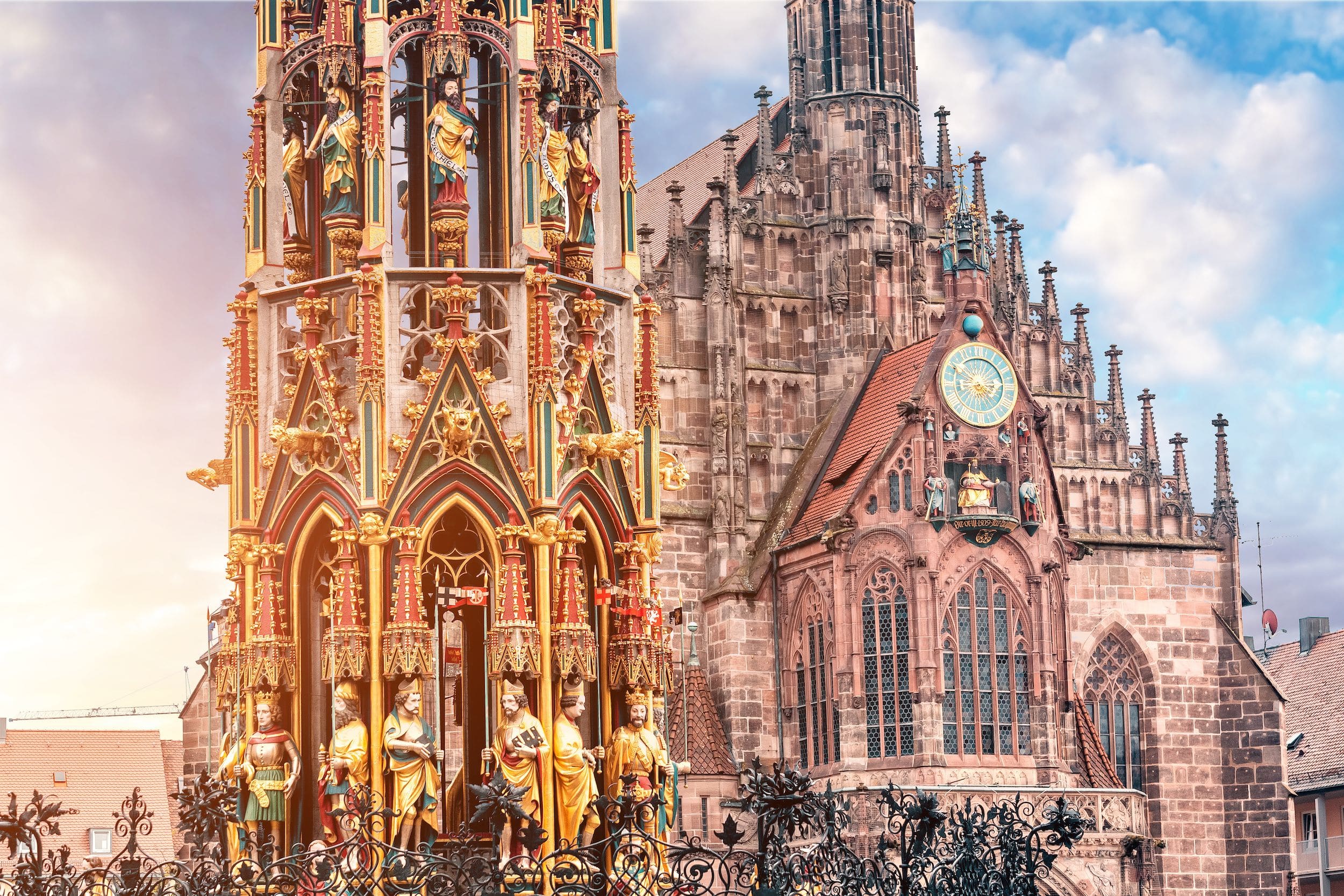
Market Square
 Highlight of Alststadt & Castle
Highlight of Alststadt & CastleShop for something tasty and check out Nuremberg's greatest architectural gems on the Market Square.
The Market Square, or Hauptmarkt, is the ideal point to start exploring the Sebald Old Town. Its two most notable features, the magnificent Frauenkirche (Church of Our Lady) and Schöner Brunnen were built in the 14th century. For many visitors, the colorful fountain is the most memorable site in Nuremberg, with its forty statues depicting figures from the Bible, mythology, and German history. The city’s famous Christmas Market is launched from the Frauenkirche’s balcony each year, and the clock on its gable performs a daily show at noon, as a procession of noblemen pays homage to the seated Emperor Charles IV. The interior of the church is also worth a visit, with its collection of altars and artwork taken from nearby monasteries. The square is also an open-air market for vendors of produce, meats, baked goods, & gifts.
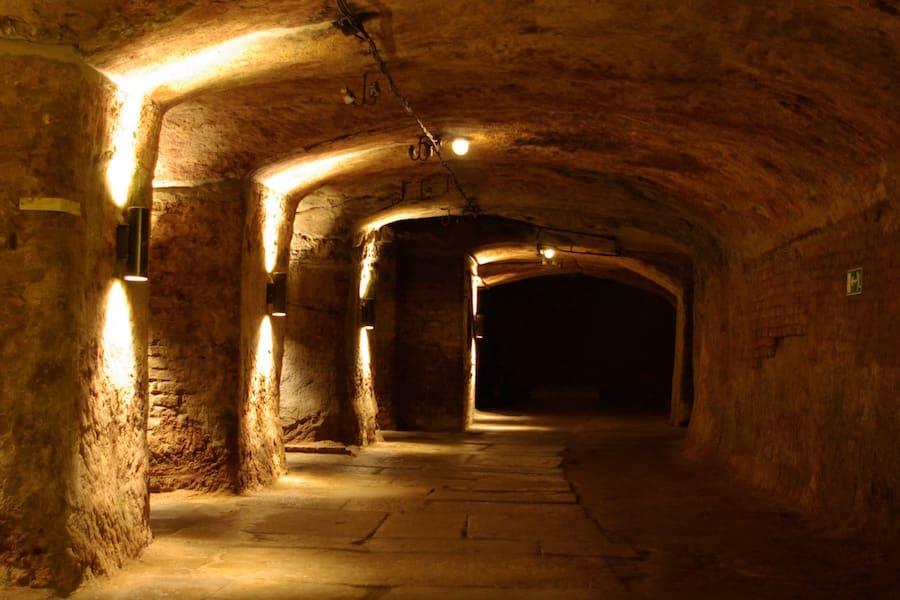
Historic Beer Cellars (Felsangänge)
 Highlight of Alststadt & Castle
Highlight of Alststadt & CastleTake a guided tour within the labyrinthine underground rock passages where Nuremberg's burghers stored their beer.
Another highlight of the Old Town are the chilly beer cellars below it. Bring a sweater or jacket, as the temperature averages about 46° F / 8° C. Carved through sandstone bedrock, the cellars form an interconnected maze that served as storage for ripening beer. During World War II they also provided a refuge from Allied bombing raids and saved thousands of lives with their good ventilation.

Albrecht Dürer House Visitor
 Highlight of Alststadt & Castle
Highlight of Alststadt & CastleTour the well-preserved Gothic home of the famed Renaissance artist Albrecht Dürer.
The former residence of the artist is interesting on several levels. The well-preserved interiors host a museum illustrate how a well-off family in the Renaissance lived, and explains how Dürer worked from his home. It does not hold any of his original paintings, nor of his woodcut prints. However, it illustrates the influence Dürer had in making art accessible to the masses through his revolutionary use of woodcuts in the then new era of the printing press. Very worthwhile.

Weißgerbergasse
 Highlight of Alststadt & Castle
Highlight of Alststadt & CastleTake a stroll down Nuremberg’s most charming street.
Beautifully painted half-timbered houses line the street, each with some interesting architectural detail to discover. Most of the houses are filled with restaurants, shops, galleries, and pubs, so you will certainly find a reason to linger.

Imperial Castle
 Highlight of Alststadt & Castle
Highlight of Alststadt & CastleMake the gentle climb up to this 11th-century castle to enjoy a beautiful view of Nuremberg's old town.
The castle is open for tours and is one of Nuremberg's top attractions. The castle’s history stretches back to the early Middle Ages when it began as a simple wooden fort on the hilltop. It grew increasingly more intricate and impressive over the centuries. While it was officially a castle of the Holy Roman Emperor, it was controlled by local noblemen known as Burgraves, creating a never-ending source of conflict with the independent-minded city just below the castle. The city finally gained control of the castle from the Emperor in 1422, shortly after having burned much of it down. The castle still remained an imperial castle, however, and would host the Emperors during their frequent visits to the city.

Market Square
 Highlight of Alststadt & Castle
Highlight of Alststadt & CastleShop for something tasty and check out Nuremberg's greatest architectural gems on the Market Square.
The Market Square, or Hauptmarkt, is the ideal point to start exploring the Sebald Old Town. Its two most notable features, the magnificent Frauenkirche (Church of Our Lady) and Schöner Brunnen were built in the 14th century. For many visitors, the colorful fountain is the most memorable site in Nuremberg, with its forty statues depicting figures from the Bible, mythology, and German history. The city’s famous Christmas Market is launched from the Frauenkirche’s balcony each year, and the clock on its gable performs a daily show at noon, as a procession of noblemen pays homage to the seated Emperor Charles IV. The interior of the church is also worth a visit, with its collection of altars and artwork taken from nearby monasteries. The square is also an open-air market for vendors of produce, meats, baked goods, & gifts.

Historic Beer Cellars (Felsangänge)
 Highlight of Alststadt & Castle
Highlight of Alststadt & CastleTake a guided tour within the labyrinthine underground rock passages where Nuremberg's burghers stored their beer.
Another highlight of the Old Town are the chilly beer cellars below it. Bring a sweater or jacket, as the temperature averages about 46° F / 8° C. Carved through sandstone bedrock, the cellars form an interconnected maze that served as storage for ripening beer. During World War II they also provided a refuge from Allied bombing raids and saved thousands of lives with their good ventilation.

Albrecht Dürer House Visitor
 Highlight of Alststadt & Castle
Highlight of Alststadt & CastleTour the well-preserved Gothic home of the famed Renaissance artist Albrecht Dürer.
The former residence of the artist is interesting on several levels. The well-preserved interiors host a museum illustrate how a well-off family in the Renaissance lived, and explains how Dürer worked from his home. It does not hold any of his original paintings, nor of his woodcut prints. However, it illustrates the influence Dürer had in making art accessible to the masses through his revolutionary use of woodcuts in the then new era of the printing press. Very worthwhile.
prev
next

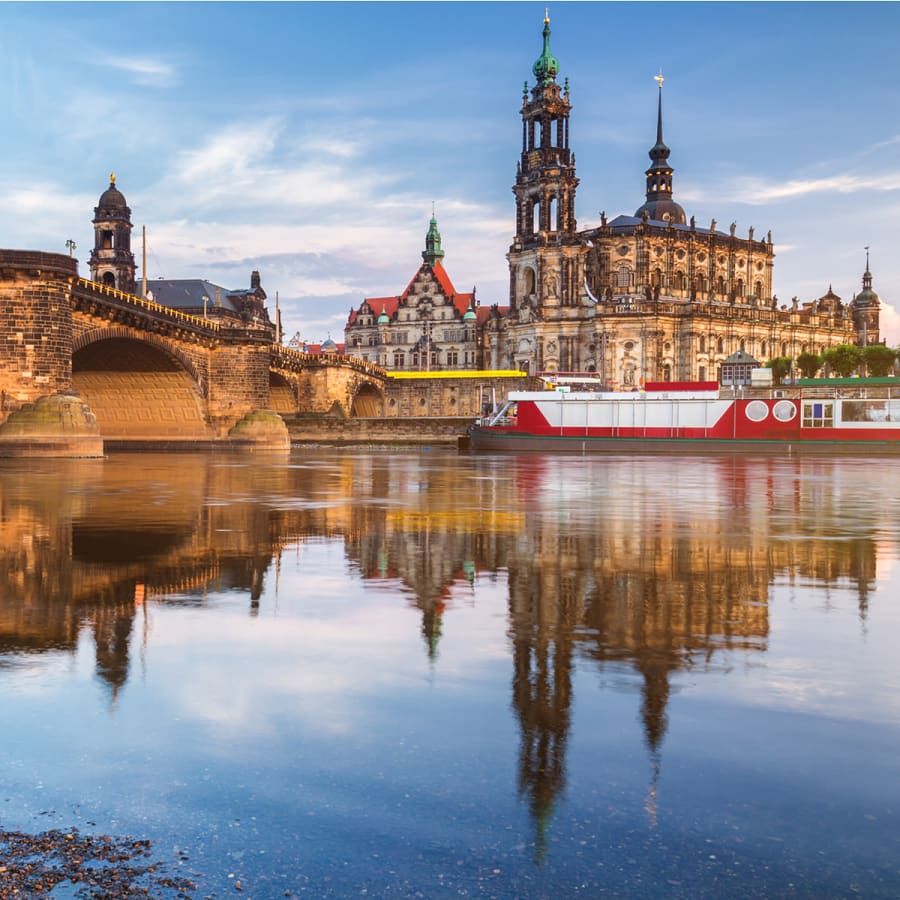
Day 6
Dresden
Day 6
Dresden



9:00 AM - 11:30 AM
Guided Walking Tour of Old Town
During this 2 hour tour you will discover the most impressive sights of Dresden Old Town, like the world famous Zwinger Palace, the Semper Opera House, the Cathedral or the Royal Palace. Our guide will give you all the historic background. You will also have a chance to see the reconstructed Frauenkirche, a symbol of reconciliation and peace in the world, a real pride of inhabitants of Dresden.

Zwinger Palace
See why the palace and its gardens were considered beautiful enough to hold some of Germany's most precious artworks.
Show More

Zwinger Palace
See why the palace and its gardens were considered beautiful enough to hold some of Germany's most precious artworks.
Show More

Zwinger Palace
See why the palace and its gardens were considered beautiful enough to hold some of Germany's most precious artworks.
Show More

Zwinger Palace
See why the palace and its gardens were considered beautiful enough to hold some of Germany's most precious artworks.
Show More

Zwinger Palace
See why the palace and its gardens were considered beautiful enough to hold some of Germany's most precious artworks.
Show More
prev
next

Day 6
Dresden

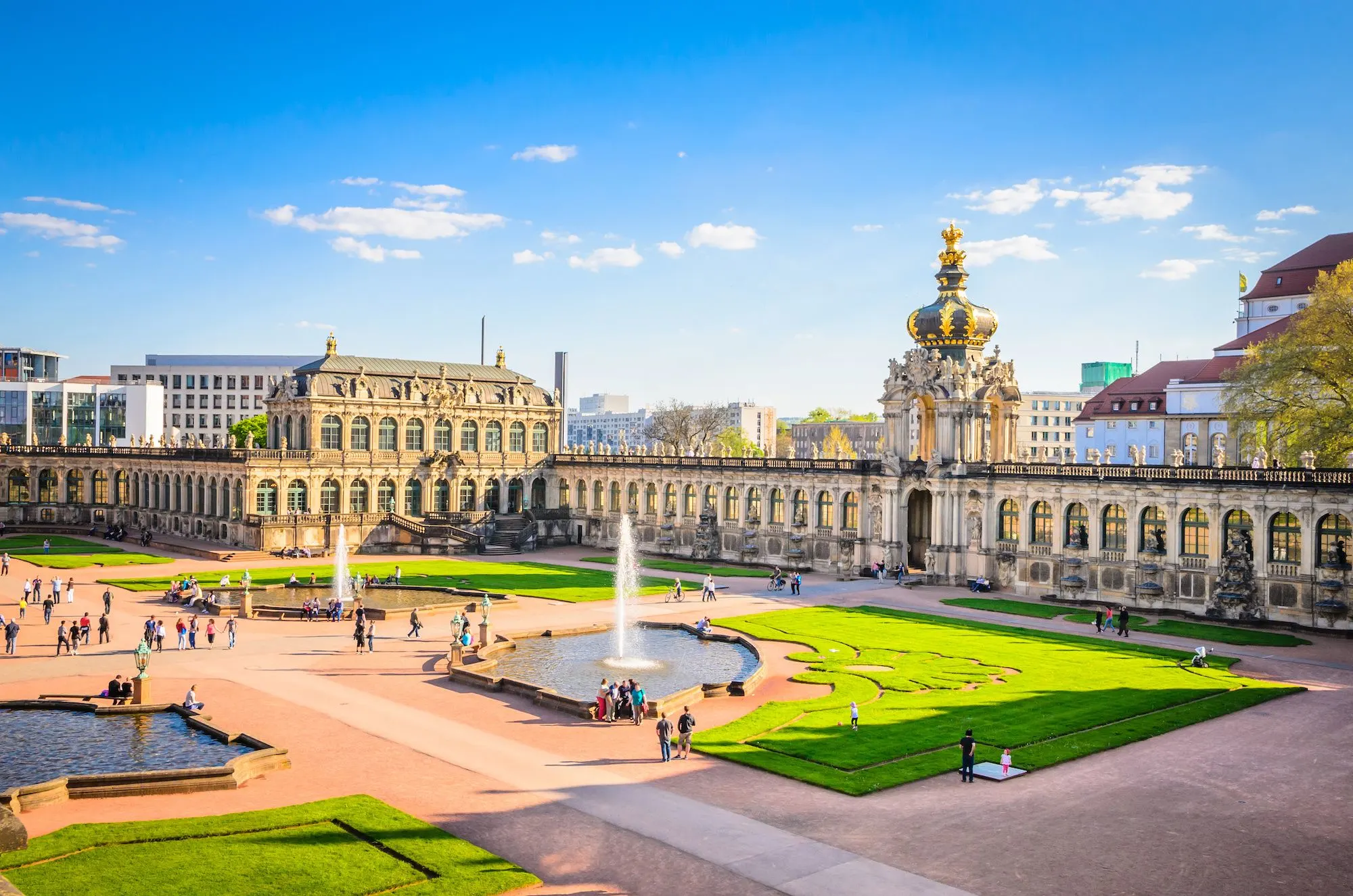
Zwinger Palace
 Highlight of Old Town Walking Tour
Highlight of Old Town Walking TourSee why the palace and its gardens were considered beautiful enough to hold some of Germany's most precious artworks.
There is much to see in the Zwinger besides the Old Masters' Gallery. The palace is one of the most admired Baroque structures in all of Germany, if not in Europe, so the architecture and gardens are attractions in themselves. There is also a porcelain collection and Royal Cabinet of Mathematical and Physical Instruments. The palace was originally built in 1709 as an orangery and garden. However, its beautifully adorned galleries and pavilions were intended to eventually serve as a forecourt for a much larger palace, which would be a testament to the power and greatness of Saxony's then ruler, Augustus the Strong. After his death that plan was dropped, and it would not be until the 19th century that the palace would find a suitable role to live up to its grandness, when it was transformed into a museum complex.

Zwinger Palace
 Highlight of Old Town Walking Tour
Highlight of Old Town Walking TourSee why the palace and its gardens were considered beautiful enough to hold some of Germany's most precious artworks.
There is much to see in the Zwinger besides the Old Masters' Gallery. The palace is one of the most admired Baroque structures in all of Germany, if not in Europe, so the architecture and gardens are attractions in themselves. There is also a porcelain collection and Royal Cabinet of Mathematical and Physical Instruments. The palace was originally built in 1709 as an orangery and garden. However, its beautifully adorned galleries and pavilions were intended to eventually serve as a forecourt for a much larger palace, which would be a testament to the power and greatness of Saxony's then ruler, Augustus the Strong. After his death that plan was dropped, and it would not be until the 19th century that the palace would find a suitable role to live up to its grandness, when it was transformed into a museum complex.

Zwinger Palace
 Highlight of Old Town Walking Tour
Highlight of Old Town Walking TourSee why the palace and its gardens were considered beautiful enough to hold some of Germany's most precious artworks.
There is much to see in the Zwinger besides the Old Masters' Gallery. The palace is one of the most admired Baroque structures in all of Germany, if not in Europe, so the architecture and gardens are attractions in themselves. There is also a porcelain collection and Royal Cabinet of Mathematical and Physical Instruments. The palace was originally built in 1709 as an orangery and garden. However, its beautifully adorned galleries and pavilions were intended to eventually serve as a forecourt for a much larger palace, which would be a testament to the power and greatness of Saxony's then ruler, Augustus the Strong. After his death that plan was dropped, and it would not be until the 19th century that the palace would find a suitable role to live up to its grandness, when it was transformed into a museum complex.

Zwinger Palace
 Highlight of Old Town Walking Tour
Highlight of Old Town Walking TourSee why the palace and its gardens were considered beautiful enough to hold some of Germany's most precious artworks.
There is much to see in the Zwinger besides the Old Masters' Gallery. The palace is one of the most admired Baroque structures in all of Germany, if not in Europe, so the architecture and gardens are attractions in themselves. There is also a porcelain collection and Royal Cabinet of Mathematical and Physical Instruments. The palace was originally built in 1709 as an orangery and garden. However, its beautifully adorned galleries and pavilions were intended to eventually serve as a forecourt for a much larger palace, which would be a testament to the power and greatness of Saxony's then ruler, Augustus the Strong. After his death that plan was dropped, and it would not be until the 19th century that the palace would find a suitable role to live up to its grandness, when it was transformed into a museum complex.

Zwinger Palace
 Highlight of Old Town Walking Tour
Highlight of Old Town Walking TourSee why the palace and its gardens were considered beautiful enough to hold some of Germany's most precious artworks.
There is much to see in the Zwinger besides the Old Masters' Gallery. The palace is one of the most admired Baroque structures in all of Germany, if not in Europe, so the architecture and gardens are attractions in themselves. There is also a porcelain collection and Royal Cabinet of Mathematical and Physical Instruments. The palace was originally built in 1709 as an orangery and garden. However, its beautifully adorned galleries and pavilions were intended to eventually serve as a forecourt for a much larger palace, which would be a testament to the power and greatness of Saxony's then ruler, Augustus the Strong. After his death that plan was dropped, and it would not be until the 19th century that the palace would find a suitable role to live up to its grandness, when it was transformed into a museum complex.
prev
next

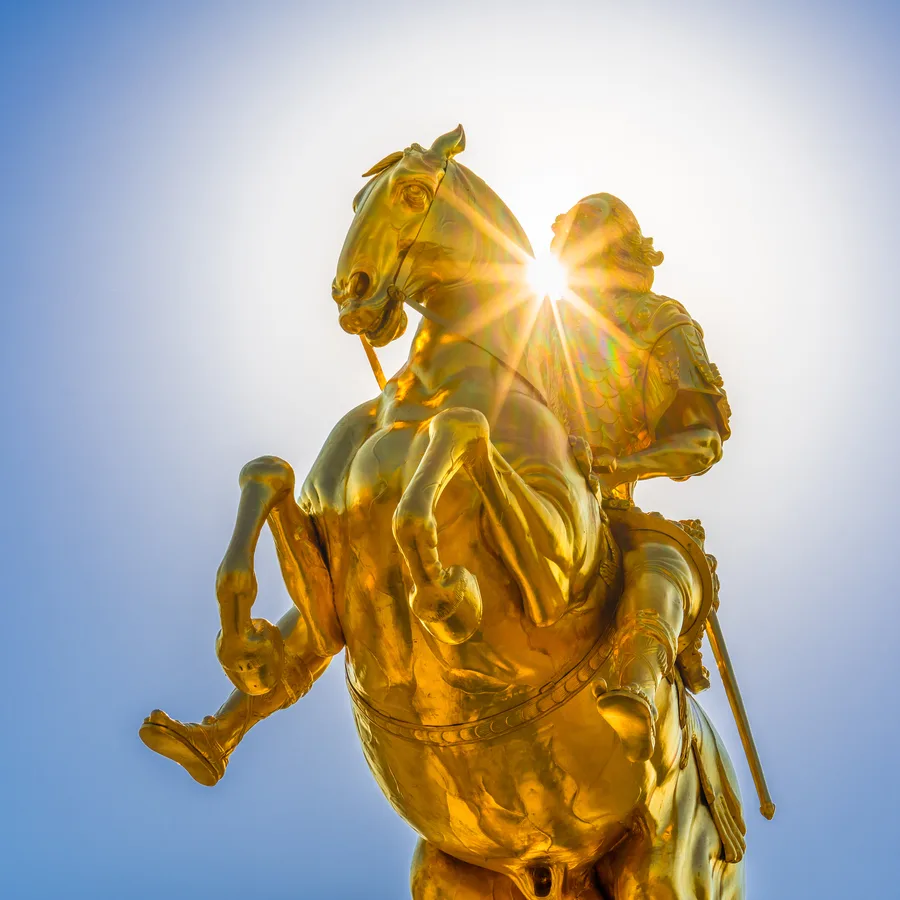
Day 7
Dresden to Berlin
Day 7
Dresden to Berlin





Morning
Cross the River to Discover the "New Town"
Completely different to Altstadt in feel and ambiance, Neustadt on the right bank of the River Elbe is far less touristed and is the favorite stomping ground of Dresdener youth thanks to its proliferation of cheaper restaurants, cafes, and pubs. Neustadt means New Town, but its history stretches back centuries and it's only new in comparison to the Old Town on the opposite side of the river. Less damaged than the Altstadt in the firestorm bombing raid of February 1945, the riverbank is populated with exquisitely constructed palaces, administrative buildings, and museums, while Königstraße still hosts an array of 18th-century Baroque townhouses. The more modern Hauptstraße leads you to the fascinating DDR World Museum depicting life under the former communist regime. Strolling along the river and enjoying the parks and statuary along the banks is a great way to see the locals relaxing.

Goldener Reiter
See a gold-covered statue of the man who re-made Dresden to advertise his greatness.
Show More

Goldener Reiter
See a gold-covered statue of the man who re-made Dresden to advertise his greatness.
Show More

Goldener Reiter
See a gold-covered statue of the man who re-made Dresden to advertise his greatness.
Show More

Goldener Reiter
See a gold-covered statue of the man who re-made Dresden to advertise his greatness.
Show More

Goldener Reiter
See a gold-covered statue of the man who re-made Dresden to advertise his greatness.
Show More
prev
next

Day 7
Dresden to Berlin


Goldener Reiter
 Highlight of Neustadt
Highlight of NeustadtSee a gold-covered statue of the man who re-made Dresden to advertise his greatness.
Golden Rider statue of Augustus the Strong. Famed statue covered in gold leaf of King August II dressed as a Roman Caesar & riding a horse.

Goldener Reiter
 Highlight of Neustadt
Highlight of NeustadtSee a gold-covered statue of the man who re-made Dresden to advertise his greatness.
Golden Rider statue of Augustus the Strong. Famed statue covered in gold leaf of King August II dressed as a Roman Caesar & riding a horse.

Goldener Reiter
 Highlight of Neustadt
Highlight of NeustadtSee a gold-covered statue of the man who re-made Dresden to advertise his greatness.
Golden Rider statue of Augustus the Strong. Famed statue covered in gold leaf of King August II dressed as a Roman Caesar & riding a horse.

Goldener Reiter
 Highlight of Neustadt
Highlight of NeustadtSee a gold-covered statue of the man who re-made Dresden to advertise his greatness.
Golden Rider statue of Augustus the Strong. Famed statue covered in gold leaf of King August II dressed as a Roman Caesar & riding a horse.

Goldener Reiter
 Highlight of Neustadt
Highlight of NeustadtSee a gold-covered statue of the man who re-made Dresden to advertise his greatness.
Golden Rider statue of Augustus the Strong. Famed statue covered in gold leaf of King August II dressed as a Roman Caesar & riding a horse.
prev
next


Day 8
Berlin
Day 8
Berlin



9:30 AM - 12:00 PM
Highlights of Berlin Guided Walking Tour
On this 3 hour tour, your guide will show you the highlights of Berlin and help you understand what makes this city so unique. Sites visited will include the boulevard Unter den Linden, the Gendarmenmarkt, Check Point Charlie, remnants of the Berlin Wall, Potsdamer Platz, the Holocaust Memorial, the Brandenburg Gate, and the Reichstag.

Brandenburg Gate
Quadriga. Hey, There's a Word to Know When Learning About this Historic Gate
Show More

Reichstag
Make your way to the top of the dome enjoying amazing views and looking down at debating members of the German Parliament below.
Show More

Brandenburg Gate
Quadriga. Hey, There's a Word to Know When Learning About this Historic Gate
Show More

Reichstag
Make your way to the top of the dome enjoying amazing views and looking down at debating members of the German Parliament below.
Show More

Brandenburg Gate
Quadriga. Hey, There's a Word to Know When Learning About this Historic Gate
Show More

Reichstag
Make your way to the top of the dome enjoying amazing views and looking down at debating members of the German Parliament below.
Show More
prev
next

Day 8
Berlin

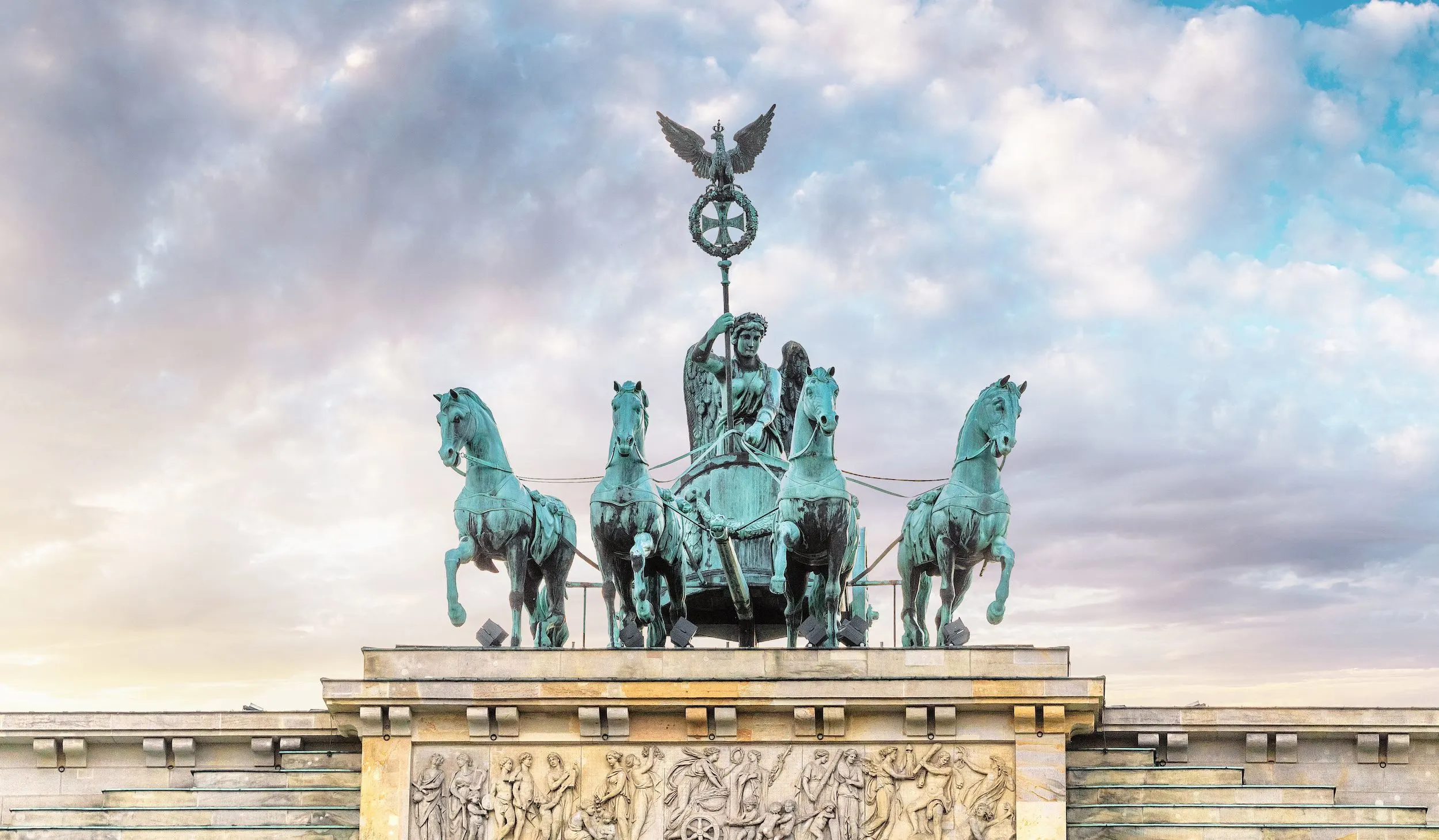
Brandenburg Gate
 Highlight of Guided Walking Tour of Berlin
Highlight of Guided Walking Tour of BerlinQuadriga. Hey, There's a Word to Know When Learning About this Historic Gate
The Brandenburg Gate was built as a symbol of peace, perverted into a symbol of power by the Nazis, and became a symbol of division during the Cold War. Now, however, it is a symbol of reunification. Completed in 1791, it was topped by the quadriga, a chariot drawn by four horses driven by the goddess of peace. Napoleon seized the quadriga as a spoil of war, but after his defeat, it was returned to the city and met by cheering crowds along the way, transforming the goddess of peace into a goddess of victory, holding a Germanic cross.

Reichstag
 Highlight of Guided Walking Tour of Berlin
Highlight of Guided Walking Tour of BerlinMake your way to the top of the dome enjoying amazing views and looking down at debating members of the German Parliament below.
Officially, the Reichstag is actually the Bundestag, which means the federal parliament. The Reichstag was reduced to a ruined shell by arson in 1933 and by World War II fighting, but it was rebuilt with a striking egg-shaped glass dome. Visitors are given a free audio guide that discusses the building’s history and architecture, while also orientating you to the sites of Berlin. It is an excellent introduction to the city. Note that it is usually necessary to book well in advance!

Brandenburg Gate
 Highlight of Guided Walking Tour of Berlin
Highlight of Guided Walking Tour of BerlinQuadriga. Hey, There's a Word to Know When Learning About this Historic Gate
The Brandenburg Gate was built as a symbol of peace, perverted into a symbol of power by the Nazis, and became a symbol of division during the Cold War. Now, however, it is a symbol of reunification. Completed in 1791, it was topped by the quadriga, a chariot drawn by four horses driven by the goddess of peace. Napoleon seized the quadriga as a spoil of war, but after his defeat, it was returned to the city and met by cheering crowds along the way, transforming the goddess of peace into a goddess of victory, holding a Germanic cross.

Reichstag
 Highlight of Guided Walking Tour of Berlin
Highlight of Guided Walking Tour of BerlinMake your way to the top of the dome enjoying amazing views and looking down at debating members of the German Parliament below.
Officially, the Reichstag is actually the Bundestag, which means the federal parliament. The Reichstag was reduced to a ruined shell by arson in 1933 and by World War II fighting, but it was rebuilt with a striking egg-shaped glass dome. Visitors are given a free audio guide that discusses the building’s history and architecture, while also orientating you to the sites of Berlin. It is an excellent introduction to the city. Note that it is usually necessary to book well in advance!

Brandenburg Gate
 Highlight of Guided Walking Tour of Berlin
Highlight of Guided Walking Tour of BerlinQuadriga. Hey, There's a Word to Know When Learning About this Historic Gate
The Brandenburg Gate was built as a symbol of peace, perverted into a symbol of power by the Nazis, and became a symbol of division during the Cold War. Now, however, it is a symbol of reunification. Completed in 1791, it was topped by the quadriga, a chariot drawn by four horses driven by the goddess of peace. Napoleon seized the quadriga as a spoil of war, but after his defeat, it was returned to the city and met by cheering crowds along the way, transforming the goddess of peace into a goddess of victory, holding a Germanic cross.

Reichstag
 Highlight of Guided Walking Tour of Berlin
Highlight of Guided Walking Tour of BerlinMake your way to the top of the dome enjoying amazing views and looking down at debating members of the German Parliament below.
Officially, the Reichstag is actually the Bundestag, which means the federal parliament. The Reichstag was reduced to a ruined shell by arson in 1933 and by World War II fighting, but it was rebuilt with a striking egg-shaped glass dome. Visitors are given a free audio guide that discusses the building’s history and architecture, while also orientating you to the sites of Berlin. It is an excellent introduction to the city. Note that it is usually necessary to book well in advance!
prev
next

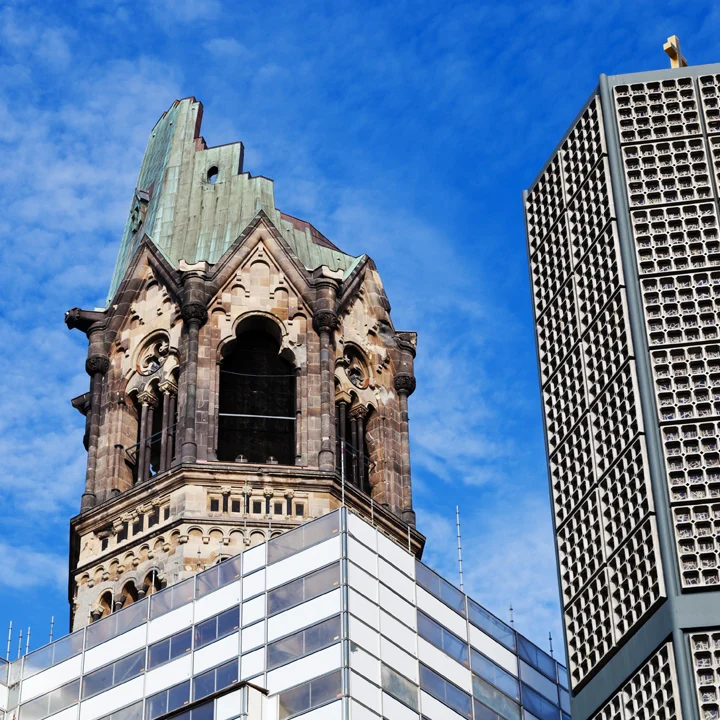
Day 9
Berlin
Day 9
Berlin



Early Morning/Morning
Stroll the Kurfürstendamm in West Berlin
In the 1920's the elegant, tree-line boulevard known as the Kurfürstendamm was the center of Berlin's nightlife and leisure scene, attracting writers, film stars, and artists. WWII left it in ruins, and today at the end of the boulevard you'll discover a chilling reminder of that destruction: the purposefully unrecontructed remains of the Memorial Church. During the Cold War, the Kurfürstendamm and its surroundings were central to West Berlin's revitalized identity. This was perhaps best symbolized by the famous KaDeWe, the gigantic department store which served as a symbol of market capitalism lodged in the heart of the Iron Curtain.

Berlin Zoo
Visit Germany's Oldest and Best Known Zoo.
Show More

KaDeWe
Shop in the iconic department store of capitalist West Berlin
Show More

Memorial Church
Remind yourself of war's destructiveness by visiting the ruins of this church destroyed during WWII.
Show More

Story of Berlin Museum
Take an interactive crash course in Berlin history. (Re-opening Autumn 2021)
Show More

Berlin Zoo
Visit Germany's Oldest and Best Known Zoo.
Show More

KaDeWe
Shop in the iconic department store of capitalist West Berlin
Show More

Memorial Church
Remind yourself of war's destructiveness by visiting the ruins of this church destroyed during WWII.
Show More

Story of Berlin Museum
Take an interactive crash course in Berlin history. (Re-opening Autumn 2021)
Show More
prev
next

Day 9
Berlin

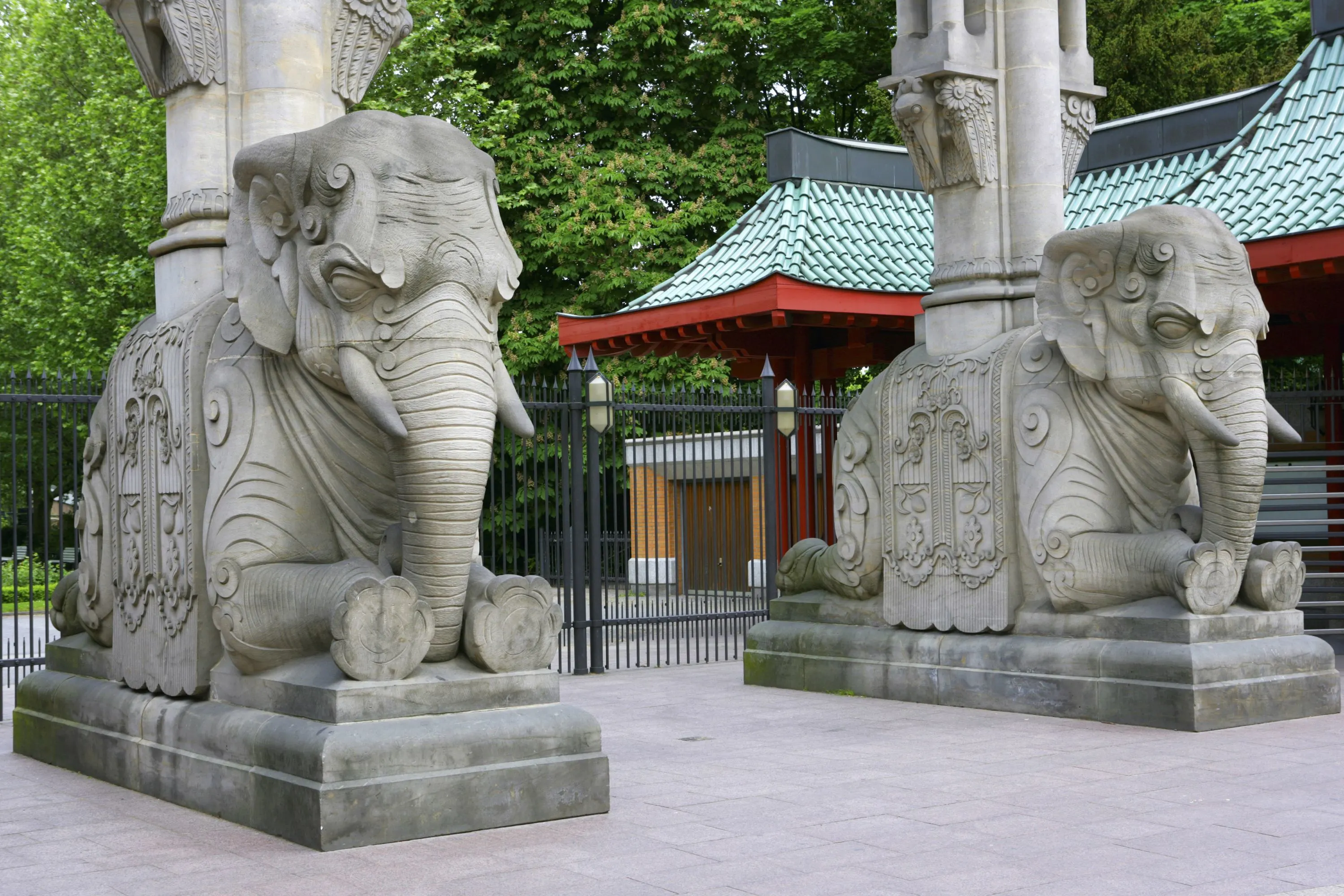
Berlin Zoo
 Highlight of City West
Highlight of City WestVisit Germany's Oldest and Best Known Zoo.
Founded in 1844, the Zoologischer Garten Berlin was the first zoo in Germany and features some wonderful animal-inspired architecture as well. The original animals were donated by King Frederick William IV of Prussia, and it now has a collection of around 20,500 animals representing 1,500 different species. The zoo’s aquarium opened in 1913 and now contains one of the largest collections of aquatic life in Europe.
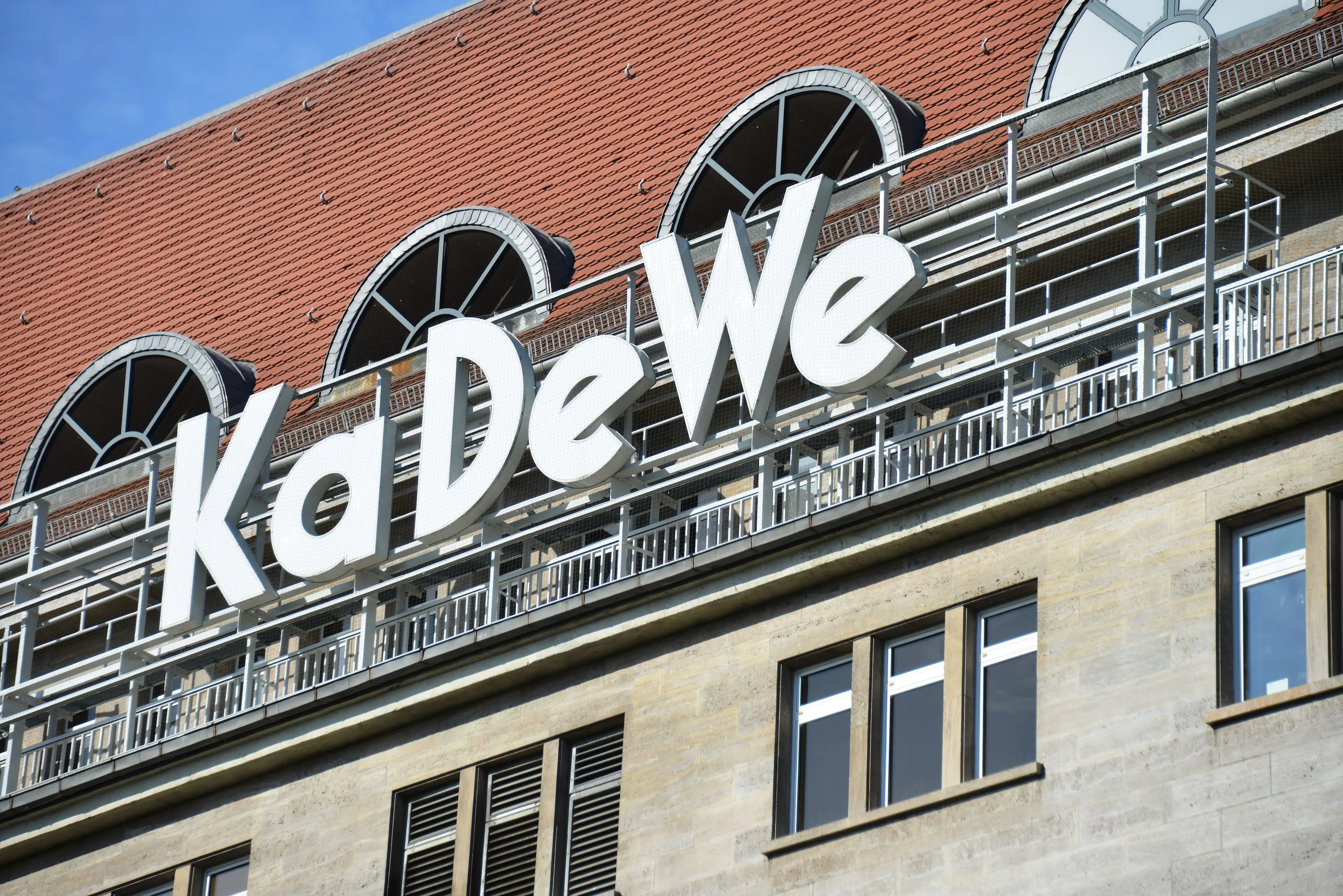
KaDeWe
 Highlight of City West
Highlight of City WestShop in the iconic department store of capitalist West Berlin
Opened in 1907, the Kaufhaus des Westens, or KaDeWe, quickly became a temple of luxury in a rapidly modernising city. It took off again following the German post-war economic miracle and gained new impetus again following German reunification. During Communism, due to it's proximity to East Germany, it became a symbol of the material wealth of the West in comparison to that of countries stuck behind the Iron Curtain.

Memorial Church
 Highlight of City West
Highlight of City WestRemind yourself of war's destructiveness by visiting the ruins of this church destroyed during WWII.
After its destruction in WWII, the Kaiser Wilhelm Memorial Church was partially rebuilt in modernist style, and partially left in ruins as a powerful reminder of the war. Built-in the 1890s, Kaiser Wilhelm II hoped to inspire the secular proletariat to return to traditional religious values. The neo-Gothic design became ever more colorful as Wilhelm insisted on more bling. The small exhibition inside shows the wartime destruction and a “before and after” model of the city center.
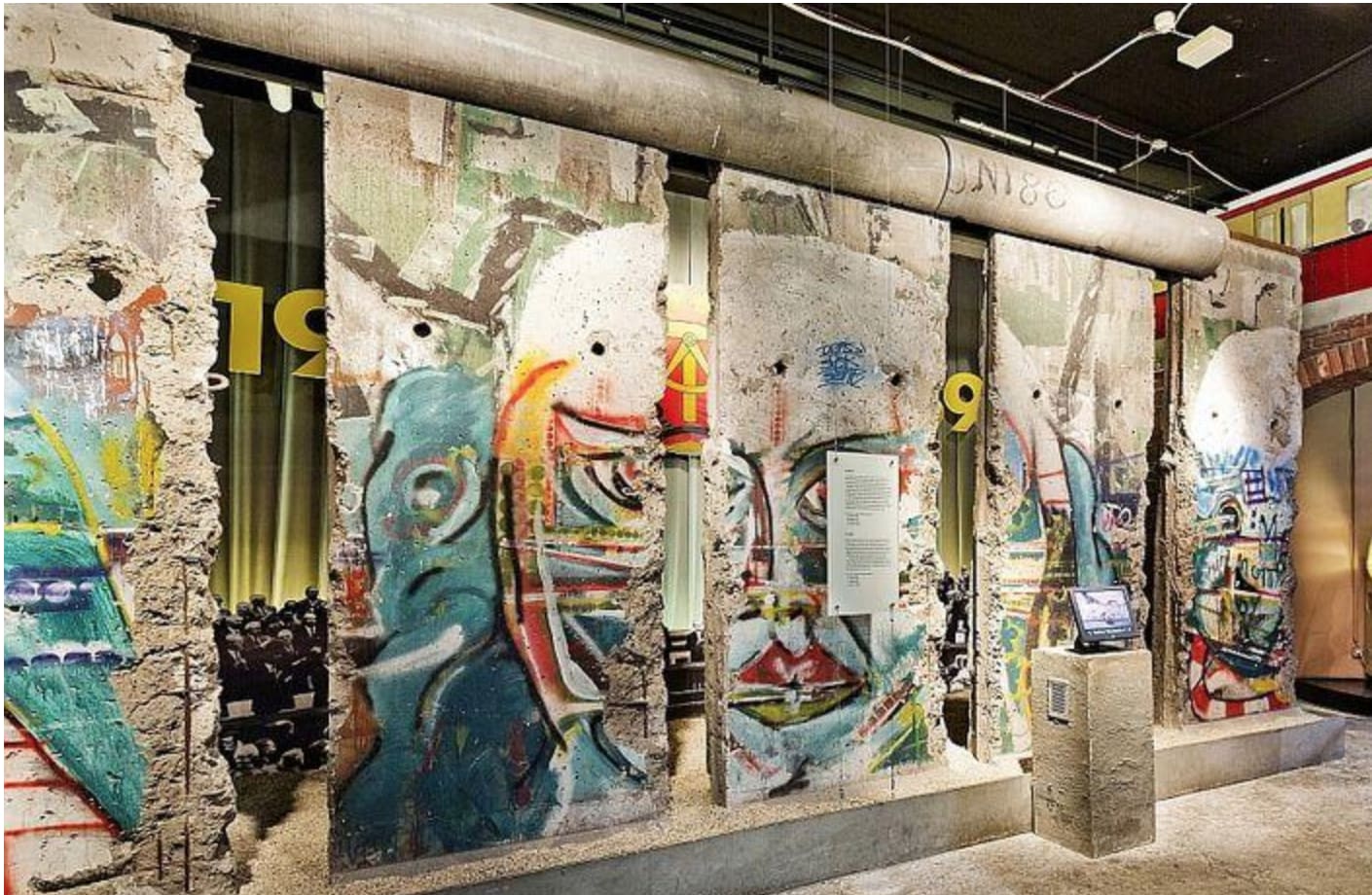
Story of Berlin Museum
 Highlight of City West
Highlight of City WestTake an interactive crash course in Berlin history. (Re-opening Autumn 2021)
This museum uses reconstructed street scapes, homes, and other interactive exibits to give you good feeling for the atmosphere of Berlin during it's long and often times turbulent history, including during the Nazi and Communist era. You can also tour an underground nuclear shelter.

Berlin Zoo
 Highlight of City West
Highlight of City WestVisit Germany's Oldest and Best Known Zoo.
Founded in 1844, the Zoologischer Garten Berlin was the first zoo in Germany and features some wonderful animal-inspired architecture as well. The original animals were donated by King Frederick William IV of Prussia, and it now has a collection of around 20,500 animals representing 1,500 different species. The zoo’s aquarium opened in 1913 and now contains one of the largest collections of aquatic life in Europe.

KaDeWe
 Highlight of City West
Highlight of City WestShop in the iconic department store of capitalist West Berlin
Opened in 1907, the Kaufhaus des Westens, or KaDeWe, quickly became a temple of luxury in a rapidly modernising city. It took off again following the German post-war economic miracle and gained new impetus again following German reunification. During Communism, due to it's proximity to East Germany, it became a symbol of the material wealth of the West in comparison to that of countries stuck behind the Iron Curtain.

Memorial Church
 Highlight of City West
Highlight of City WestRemind yourself of war's destructiveness by visiting the ruins of this church destroyed during WWII.
After its destruction in WWII, the Kaiser Wilhelm Memorial Church was partially rebuilt in modernist style, and partially left in ruins as a powerful reminder of the war. Built-in the 1890s, Kaiser Wilhelm II hoped to inspire the secular proletariat to return to traditional religious values. The neo-Gothic design became ever more colorful as Wilhelm insisted on more bling. The small exhibition inside shows the wartime destruction and a “before and after” model of the city center.

Story of Berlin Museum
 Highlight of City West
Highlight of City WestTake an interactive crash course in Berlin history. (Re-opening Autumn 2021)
This museum uses reconstructed street scapes, homes, and other interactive exibits to give you good feeling for the atmosphere of Berlin during it's long and often times turbulent history, including during the Nazi and Communist era. You can also tour an underground nuclear shelter.
prev
next

Day 10
Depart Berlin
Day 10
Depart Berlin

To Be Determined
Transfer to Berlin Airport by Taxi or Train
The most affordable and fast way to reach Berlin Brandenburg airport is by train. The Airport Express train takes only 30 minutes and leaves directly from the main station in central Berlin (Berlin Hbf). Regional and S-Bahn trains also depart from other locations in Berlin. Berlin taxis are generally reliable and honest, so you may wish to take a taxi or Uber, although this is more expensive than the train and puts you at the mercy of traffic. You can also arrange a private transfer. If you are picked up about 3 hours before your departure time, you should arrive at the airport with about two hours to spare, depending on traffic. If you are leaving during rush hour, you may want to budget an extra fifteen to thirty minutes.
Day 10
Depart Berlin


What's Included In Your Trip

Pre-Paid Tours and Activities:
- Guided Walk Tour of Historic Munich
- Guided Walking Tour of Old Town
- Highlights of Berlin Guided Walking Tour
- City Cards for Munich and Berlin, including discounts to many popular attractions

Pre-Paid Transportation:
- 2nd Class Train Tickets from Munich-Nuremberg
- 2nd Class Train Tickets from Nuremberg to Leipzig
- 2nd Class Train Tickets from Leipzig to Dresden
- Train Tickets from Dresden to Berlin
- Public Transport Tickets for Munich and Berlin

Accommodation:
- 3 nights at a hotel of your choice in Munich
- 3 nights at a hotel of your choice in Nuremberg
- 3 nights at a hotel of your choice in Dresden
- 4 nights at a hotel of your choice in Berlin

Go Real Travel Mobile App:
- Itinerary Plan & Reservations Info
- Points of Interest
- Detailed Travel Information
- Maps & Directions
Other Trips You May Like

10 Days
From$1899USD

12 Days
From$2449USD
12 Days in the Heart of Central Europe: Berlin, Prague, Vienna, and Munich

Germany, Czech Republic, Austria

15 Days
From$3249USD
Timeless Central Europe:: From Berlin to Vienna through the Czech Republic

Germany, Czech Republic, Austria

5 Days
From$899USD

21 Days
From$5899USD

21 Days
From$5199USD
Canals, Castles, and Culture: A Three-Week Journey in the Netherlands & Germany

Netherlands, Germany

7 Days
From$1375USD

10 Days
From$3250USD
Enchanting Christmas Market Trip to Bavaria & Prague with Gabriella-Maria

Germany, Czech Republic

10 Days
From$1995USD
An Active Adventure to Berlin, Dresden, Prague, and the Saxon Switzerland

Germany, Czech Republic

10 Days
From$1899USD

12 Days
From$2449USD
12 Days in the Heart of Central Europe: Berlin, Prague, Vienna, and Munich

Germany, Czech Republic, Austria

15 Days
From$3249USD
Timeless Central Europe:: From Berlin to Vienna through the Czech Republic

Germany, Czech Republic, Austria

5 Days
From$899USD

21 Days
From$5899USD

21 Days
From$5199USD
Canals, Castles, and Culture: A Three-Week Journey in the Netherlands & Germany

Netherlands, Germany

7 Days
From$1375USD

10 Days
From$3250USD
Enchanting Christmas Market Trip to Bavaria & Prague with Gabriella-Maria

Germany, Czech Republic

10 Days
From$1995USD
An Active Adventure to Berlin, Dresden, Prague, and the Saxon Switzerland

Germany, Czech Republic
prev
next
Featured Blogs
prev
next
Our Customers Say It Best
Marianne Strydom, Paarl, South Africa
I just wanted to thank you for organizing an amazing trip for me – I packed in so much in such a short period of time and everything was just perfect. The way you do things makes it possible to really get to know the destination, which for me as a travel agent could not have been better. 

Otto Chuy, Los Angeles, California
I am still surprised how everything worked as planned, without a hitch. All instructions in your itinerary were precise and correct. Your suggestions and comments in each of the locations we went to were very helpful. All your guides, without exception, were wonderful and exactly on time. 

Malini Dutta, Boston, Massachusetts
We can't thank you enough for the detailed plans, maps, and suggestions. It really felt that someone was holding our hands and showing us around. We had all the excitement of discovering foreign lands, with none of the problems that can happen while negotiating unfamiliar places. In fact, all the cities felt like home within a few hours of arriving and exploring. 

Bev and Mark Frankel, Williamsburg, Virginia
We could not be more pleased with Go Real Travel! You took the guess work out of things like public transport but still managed to allow us the freedom to tour as we wanted. Our guides were exceptional and every time I saw a Viking Cruise tour of 25 people, I realized the quality experience we were getting with Go Real. 

Marianne Strydom, Paarl, South Africa
I just wanted to thank you for organizing an amazing trip for me – I packed in so much in such a short period of time and everything was just perfect. The way you do things makes it possible to really get to know the destination, which for me as a travel agent could not have been better. 

Otto Chuy, Los Angeles, California
I am still surprised how everything worked as planned, without a hitch. All instructions in your itinerary were precise and correct. Your suggestions and comments in each of the locations we went to were very helpful. All your guides, without exception, were wonderful and exactly on time. 

Malini Dutta, Boston, Massachusetts
We can't thank you enough for the detailed plans, maps, and suggestions. It really felt that someone was holding our hands and showing us around. We had all the excitement of discovering foreign lands, with none of the problems that can happen while negotiating unfamiliar places. In fact, all the cities felt like home within a few hours of arriving and exploring. 

Bev and Mark Frankel, Williamsburg, Virginia
We could not be more pleased with Go Real Travel! You took the guess work out of things like public transport but still managed to allow us the freedom to tour as we wanted. Our guides were exceptional and every time I saw a Viking Cruise tour of 25 people, I realized the quality experience we were getting with Go Real. 



Explore cities in more detail
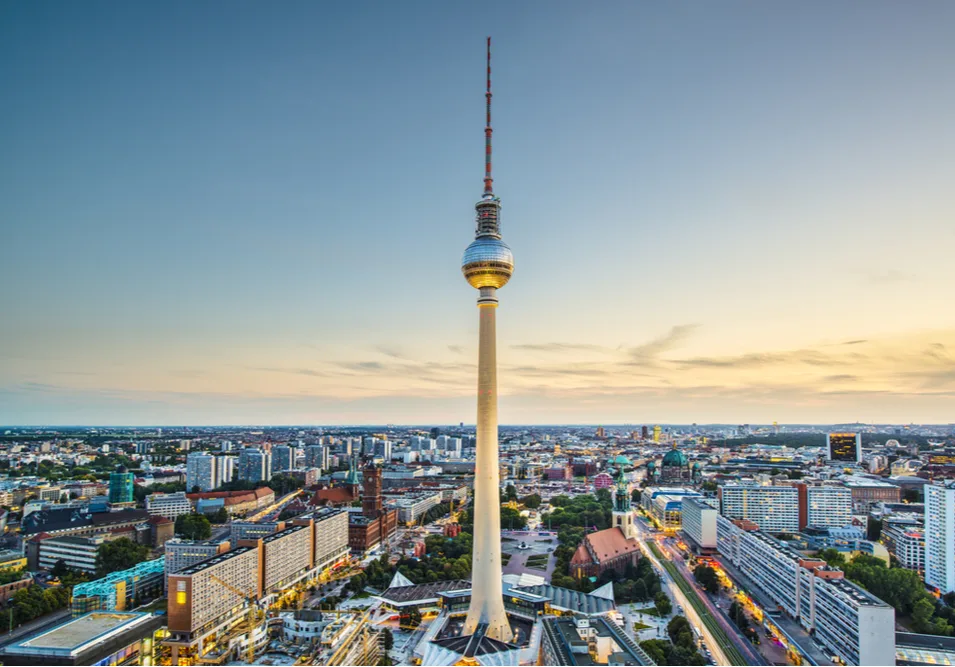
Berlin
Since the fall of its notorious wall, Berlin’s unification has seen it go from strength to strength. No wonder the city feels like it hasn’t stopped partying since the 1990s. There is so much to celebrate here. Fueled by the robust economy, a thriving tech scene, and straight-up German bonhomie, when you step into Berlin you’ll soon be caught up in its spirit. For all this gusto, Berlin hasn’t forgotten its troubled past. A visit to Berlin is to bear witness to history. Portions of the wall remain intact, and the city’s Jewish Museum offers a detailed, emotional examination of the Holocaust. Inside the reconstructed Reichstag, every attempt has been made to preserve the parliament’s beleaguered history. The buildings' glass dome addition feels less like a triumphal crown and more like a freshly healed battle scar. Days in Berlin are easily spent wandering from a cafe to the cultural institutions on Museum Island, or over to the Charlottenburg Palace. By night, crowds wander through the booming bars and nightclubs or gaze upon the floodlit Brandenburg Gate and Victory Column monuments. An international city that can offer something to everyone, Berlin is an unmissable stop on your German journey.

Learn About Berlin
Build Berlin Trip

Salzburg
You've probably heard this before— the city of Salzburg is straight out of a fairytale. Nestled in the mountains, this romantic city's Baroque architecture with colorful domes and spires is especially striking against the ancient fortress and Austrian Alpine backdrop. If you're looking for an amazing view, climb up to Hohensalzburg Fortress, Central Europe's largest intact fortress, for a jaw-dropping panorama of the city backed by misty mountains. Perhaps most famous for being the birthplace of the renowned composer Wolfgang Amadeus Mozart and the filming location for the classic The Sound of Music, this city has much to offer. Salzburg has become an important artistic and cultural center, featuring magnificent concert halls that uphold the city's tradition of classical music every day of the year, as well as acclaimed art exhibitions and museums. If you do it right, your visit to Salzburg will immerse you in the city's unforgettable atmosphere and keep you coming back for more.

Learn About Salzburg
Build Salzburg Trip

Frankfurt
Dubbed ‘Mainhatten’ for its glass highrises, financial prowess, and proximity to the Main River, Frankfurt offers a fascinating glimpse into the ‘engine room’ of Europe’s economy with an unexpected twist. Among the glass and steel buildings, the old-worldly Römerberg square will give you a double-take. The square’s 15th-century half-timbered houses, old statues, and church spires contrast dramatically against the modern 21st-century skyscrapers beyond. If you visit at Christmas, the Römerberg is truly special, aglow with the light of the tallest Christmas tree in Germany. The square fills with stalls selling handicrafts, and the air is scented with hot apple wine, honey, and cinnamon. Delve deeper into Frankfurt and you’ll find a substantial museum district, the Museumsufer (Museum Embankment). This area features a cluster of twelve museums on either side of Main River. This includes the Städel, home to Tischbein’s famous painting of renowned writer Johann Wolfgang von Goethe, one of Frankfurt’s most prestigious sons. The more time you spend in Frankfurt, the more you’ll discover a highly cultured city lurking beneath its glass facades. If you have the time, Frankfurt is certainly worth a second look.

Learn About Frankfurt
Build Frankfurt Trip
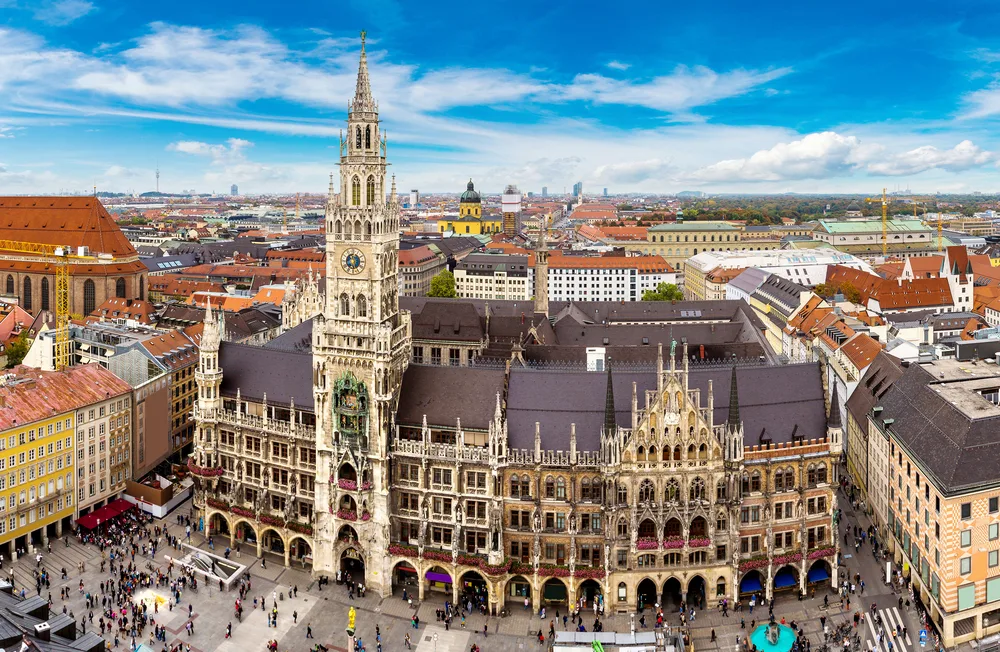
Munich
Arriving in Munich, you would be forgiven for thinking you were on the set of a movie about old Bavaria. At the Old Town beer halls, barmaids laced in dirndl dresses serve up frosty Helles lager, as oom-pah music drifts across the Marienplatz square. Men in lederhosen and checked shirts merrily give toasts as they knock glasses, or steins, as they’re known here. They sit at tables laden with wurst sausage and giant pretzels oozing with herby butter. This is Germany’s Germany, a place where folk traditions never stopped, and the revelry doesn’t either. Even when it isn’t Oktoberfest, the town’s notorious beer-drinking celebration, Munich is always happy to show you a good time. Simply cast your eyes around the lavish, gilded banquet hall at the Munich Residenz, the 13th-century Wittelsbach palace. You’ll see Munich has been impressing guests for centuries. Or, swing by the BMW Museum and check out the classic German cars. They even let you sit inside to test out the new models. At the city’s English Gardens, surfers ride waves on one of the park’s rivers. Munich is filled to the brim with this kind of pure-hearted German fun.

Learn About Munich
Build Munich Trip

Nuremberg
One of the most authentic, storied German destinations, Nuremberg's picturesque old town, glorious castle, and buzzing Christmas Market makes this city a time-true classic. The ideal gateway to old Bavaria, Nuremberg offers a primer in German history before you embark on the lovely journey through old Bavaria, known as the Romantic Road. Considered the capital of the Holy Roman Empire in the middle ages, Nuremberg would have felt like the center of the world as a procession of kings and emperors passed through its magnificent gates. When the German Renaissance came, Nuremberg was at its heart. Albrecht Dürer, the great German master artist, was born here, and Martin Luther called Nuremberg Germany's 'eyes and ears'. Skip forward a few centuries, and the city took a dark turn, as Nuremberg became a gathering point for the German National Socialists. Slightly outside of town, you can still find the Nazi Party Rallying Grounds, a sobering reminder of the not so distant past. If it all gets too heavy, you can end the day with a glass of rotbier (red beer) and mull it over. Nuremberg is a must-see for anyone who wants to delve into Germany's past.

Learn About Nuremberg
Build Nuremberg Trip

Dresden
Nearly every wall and rooftop in Dresden seems to be finished with a flourish. Defined by its ornamental baroque architecture, a power statement of Saxon royalty, Dresden is made all the more miraculous considering the city was leveled by firebombing in WWII. After the war, the city was reconstructed, brick by painstaking brick. Even under East German-Soviet rule, which usually eschewed frivolous design, buildings like the Semper Opera House were pieced back to their former glory. Restoration of the majestic Zwinger Palace and bell domed Church of Our Lady slowly followed, with the Frauenkirche only fully repaired in 2005. Arguably there is no other city in Europe that cherishes its hard-won architecture as much as Dresden. Although it is a compact city, so many of its buildings will stop you in your tracks that architecture fans will easily lose a whole day in the Old Town area. Especially during the winter months, Dresden sparkles with a joyous, uplifting ambiance. The city is recognized as having the best-ever Christmas market in all of Europe. Between the twinkling lights, the scent of hot wine and gingerbread, and the towering Christmas tree, it’s worth going out of your way to see Dresden at this time of year.

Learn About Dresden
Build Dresden Trip

Berlin
Since the fall of its notorious wall, Berlin’s unification has seen it go from strength to strength. No wonder the city feels like it hasn’t stopped partying since the 1990s. There is so much to celebrate here. Fueled by the robust economy, a thriving tech scene, and straight-up German bonhomie, when you step into Berlin you’ll soon be caught up in its spirit. For all this gusto, Berlin hasn’t forgotten its troubled past. A visit to Berlin is to bear witness to history. Portions of the wall remain intact, and the city’s Jewish Museum offers a detailed, emotional examination of the Holocaust. Inside the reconstructed Reichstag, every attempt has been made to preserve the parliament’s beleaguered history. The buildings' glass dome addition feels less like a triumphal crown and more like a freshly healed battle scar. Days in Berlin are easily spent wandering from a cafe to the cultural institutions on Museum Island, or over to the Charlottenburg Palace. By night, crowds wander through the booming bars and nightclubs or gaze upon the floodlit Brandenburg Gate and Victory Column monuments. An international city that can offer something to everyone, Berlin is an unmissable stop on your German journey.

Learn About Berlin
Build Berlin Trip

Salzburg
You've probably heard this before— the city of Salzburg is straight out of a fairytale. Nestled in the mountains, this romantic city's Baroque architecture with colorful domes and spires is especially striking against the ancient fortress and Austrian Alpine backdrop. If you're looking for an amazing view, climb up to Hohensalzburg Fortress, Central Europe's largest intact fortress, for a jaw-dropping panorama of the city backed by misty mountains. Perhaps most famous for being the birthplace of the renowned composer Wolfgang Amadeus Mozart and the filming location for the classic The Sound of Music, this city has much to offer. Salzburg has become an important artistic and cultural center, featuring magnificent concert halls that uphold the city's tradition of classical music every day of the year, as well as acclaimed art exhibitions and museums. If you do it right, your visit to Salzburg will immerse you in the city's unforgettable atmosphere and keep you coming back for more.

Learn About Salzburg
Build Salzburg Trip

Frankfurt
Dubbed ‘Mainhatten’ for its glass highrises, financial prowess, and proximity to the Main River, Frankfurt offers a fascinating glimpse into the ‘engine room’ of Europe’s economy with an unexpected twist. Among the glass and steel buildings, the old-worldly Römerberg square will give you a double-take. The square’s 15th-century half-timbered houses, old statues, and church spires contrast dramatically against the modern 21st-century skyscrapers beyond. If you visit at Christmas, the Römerberg is truly special, aglow with the light of the tallest Christmas tree in Germany. The square fills with stalls selling handicrafts, and the air is scented with hot apple wine, honey, and cinnamon. Delve deeper into Frankfurt and you’ll find a substantial museum district, the Museumsufer (Museum Embankment). This area features a cluster of twelve museums on either side of Main River. This includes the Städel, home to Tischbein’s famous painting of renowned writer Johann Wolfgang von Goethe, one of Frankfurt’s most prestigious sons. The more time you spend in Frankfurt, the more you’ll discover a highly cultured city lurking beneath its glass facades. If you have the time, Frankfurt is certainly worth a second look.

Learn About Frankfurt
Build Frankfurt Trip

Munich
Arriving in Munich, you would be forgiven for thinking you were on the set of a movie about old Bavaria. At the Old Town beer halls, barmaids laced in dirndl dresses serve up frosty Helles lager, as oom-pah music drifts across the Marienplatz square. Men in lederhosen and checked shirts merrily give toasts as they knock glasses, or steins, as they’re known here. They sit at tables laden with wurst sausage and giant pretzels oozing with herby butter. This is Germany’s Germany, a place where folk traditions never stopped, and the revelry doesn’t either. Even when it isn’t Oktoberfest, the town’s notorious beer-drinking celebration, Munich is always happy to show you a good time. Simply cast your eyes around the lavish, gilded banquet hall at the Munich Residenz, the 13th-century Wittelsbach palace. You’ll see Munich has been impressing guests for centuries. Or, swing by the BMW Museum and check out the classic German cars. They even let you sit inside to test out the new models. At the city’s English Gardens, surfers ride waves on one of the park’s rivers. Munich is filled to the brim with this kind of pure-hearted German fun.

Learn About Munich
Build Munich Trip

Nuremberg
One of the most authentic, storied German destinations, Nuremberg's picturesque old town, glorious castle, and buzzing Christmas Market makes this city a time-true classic. The ideal gateway to old Bavaria, Nuremberg offers a primer in German history before you embark on the lovely journey through old Bavaria, known as the Romantic Road. Considered the capital of the Holy Roman Empire in the middle ages, Nuremberg would have felt like the center of the world as a procession of kings and emperors passed through its magnificent gates. When the German Renaissance came, Nuremberg was at its heart. Albrecht Dürer, the great German master artist, was born here, and Martin Luther called Nuremberg Germany's 'eyes and ears'. Skip forward a few centuries, and the city took a dark turn, as Nuremberg became a gathering point for the German National Socialists. Slightly outside of town, you can still find the Nazi Party Rallying Grounds, a sobering reminder of the not so distant past. If it all gets too heavy, you can end the day with a glass of rotbier (red beer) and mull it over. Nuremberg is a must-see for anyone who wants to delve into Germany's past.

Learn About Nuremberg
Build Nuremberg Trip

Dresden
Nearly every wall and rooftop in Dresden seems to be finished with a flourish. Defined by its ornamental baroque architecture, a power statement of Saxon royalty, Dresden is made all the more miraculous considering the city was leveled by firebombing in WWII. After the war, the city was reconstructed, brick by painstaking brick. Even under East German-Soviet rule, which usually eschewed frivolous design, buildings like the Semper Opera House were pieced back to their former glory. Restoration of the majestic Zwinger Palace and bell domed Church of Our Lady slowly followed, with the Frauenkirche only fully repaired in 2005. Arguably there is no other city in Europe that cherishes its hard-won architecture as much as Dresden. Although it is a compact city, so many of its buildings will stop you in your tracks that architecture fans will easily lose a whole day in the Old Town area. Especially during the winter months, Dresden sparkles with a joyous, uplifting ambiance. The city is recognized as having the best-ever Christmas market in all of Europe. Between the twinkling lights, the scent of hot wine and gingerbread, and the towering Christmas tree, it’s worth going out of your way to see Dresden at this time of year.

Learn About Dresden
Build Dresden Trip
prev
next


 Map of Your Itinerary Route
Map of Your Itinerary Route
Zoom In to the cities to see your itinerary in more detail


 4.8
4.8 






